Critical Review: Obsessive Compulsive Disorder (OCD) In India
VerifiedAdded on 2021/05/31
|32
|9609
|15
AI Summary
Contribute Materials
Your contribution can guide someone’s learning journey. Share your
documents today.
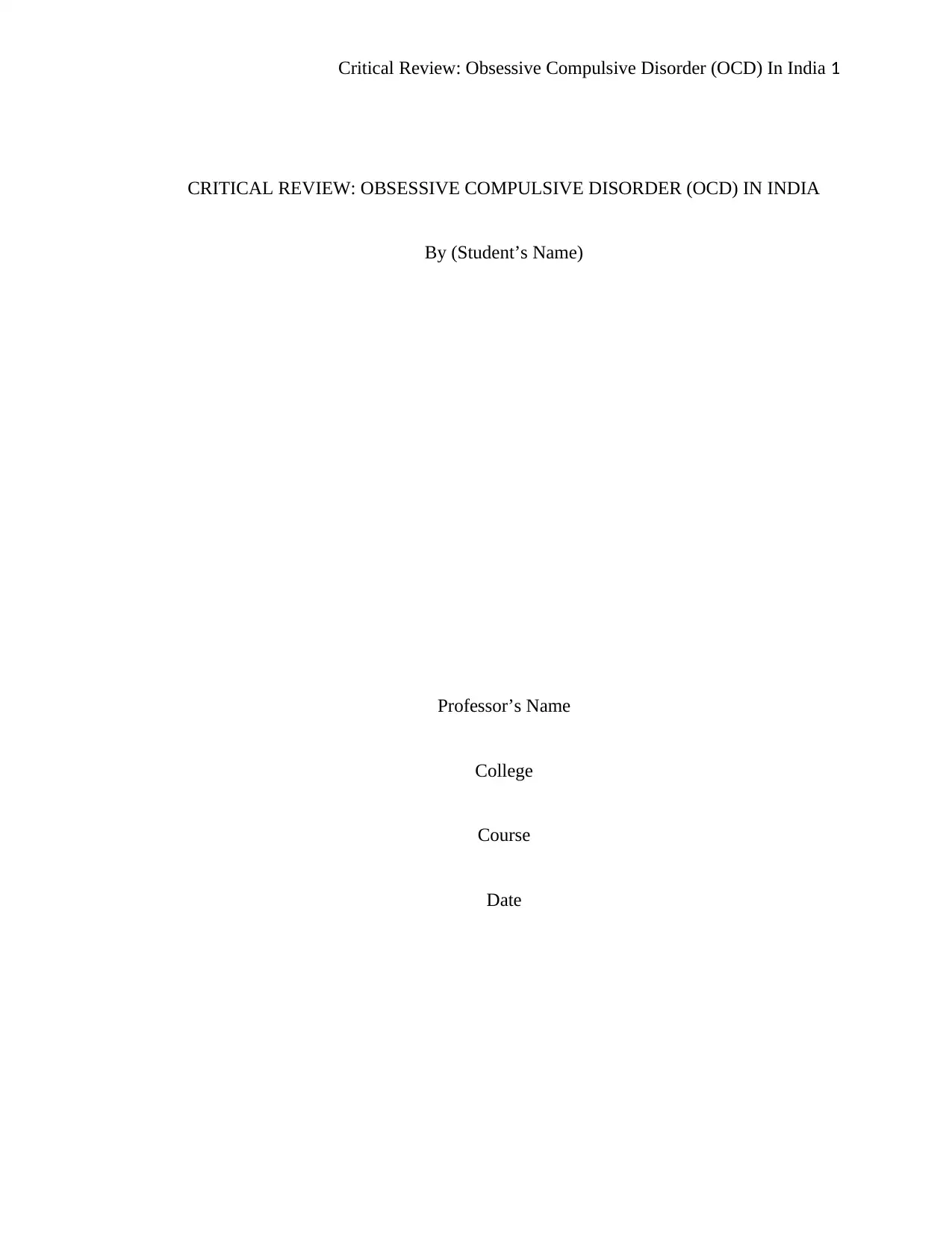
Critical Review: Obsessive Compulsive Disorder (OCD) In India 1
CRITICAL REVIEW: OBSESSIVE COMPULSIVE DISORDER (OCD) IN INDIA
By (Student’s Name)
Professor’s Name
College
Course
Date
CRITICAL REVIEW: OBSESSIVE COMPULSIVE DISORDER (OCD) IN INDIA
By (Student’s Name)
Professor’s Name
College
Course
Date
Secure Best Marks with AI Grader
Need help grading? Try our AI Grader for instant feedback on your assignments.

Critical Review: Obsessive Compulsive Disorder (OCD) In India 2
1.0 INTRODUCTION
1.1. The Focus of the Study
Children living with Obsessive Compulsive Disorder (OCD) have in past been neglected.
Not because no one cares. But the parents are most afraid to open up to the fact that their child is
suffering from a disorder. Most of the working class parents prefer staying with the children
indoors instead of allowing such children to interact. In one of the cases witnessed, a father
disowned his child and accused the mother of infidelity. This was because the father was an
upper-class economy parent who worked as a bank manager. He could not hold the thought of
having a child suffering from obsessive-compulsive disorders. Such parents make the focus of
our study and how to inform them accordingly about this type of special needs disease.
1. 2. The Aim of the Study
The study aims at informing the parents, teachers and the public the real causes of the
obsessive behavioral disorder. It also needs to access the various treatments that this child can
undergo so that the family can help them in the healing process rather than neglect them. This
study also aims at making the public understand that the disorder is not meant for a specific
social class or social group. Anyone’s child can suffer from such a disorder.
1.3. Overview
The study will focus on the evidence or particular specific behaviors that are likely to be
symptoms of obsessive-compulsive disorder. The evidence will help the public know how to
identify with such cases. When they are identified it easier to perform the different treatment at
1.0 INTRODUCTION
1.1. The Focus of the Study
Children living with Obsessive Compulsive Disorder (OCD) have in past been neglected.
Not because no one cares. But the parents are most afraid to open up to the fact that their child is
suffering from a disorder. Most of the working class parents prefer staying with the children
indoors instead of allowing such children to interact. In one of the cases witnessed, a father
disowned his child and accused the mother of infidelity. This was because the father was an
upper-class economy parent who worked as a bank manager. He could not hold the thought of
having a child suffering from obsessive-compulsive disorders. Such parents make the focus of
our study and how to inform them accordingly about this type of special needs disease.
1. 2. The Aim of the Study
The study aims at informing the parents, teachers and the public the real causes of the
obsessive behavioral disorder. It also needs to access the various treatments that this child can
undergo so that the family can help them in the healing process rather than neglect them. This
study also aims at making the public understand that the disorder is not meant for a specific
social class or social group. Anyone’s child can suffer from such a disorder.
1.3. Overview
The study will focus on the evidence or particular specific behaviors that are likely to be
symptoms of obsessive-compulsive disorder. The evidence will help the public know how to
identify with such cases. When they are identified it easier to perform the different treatment at
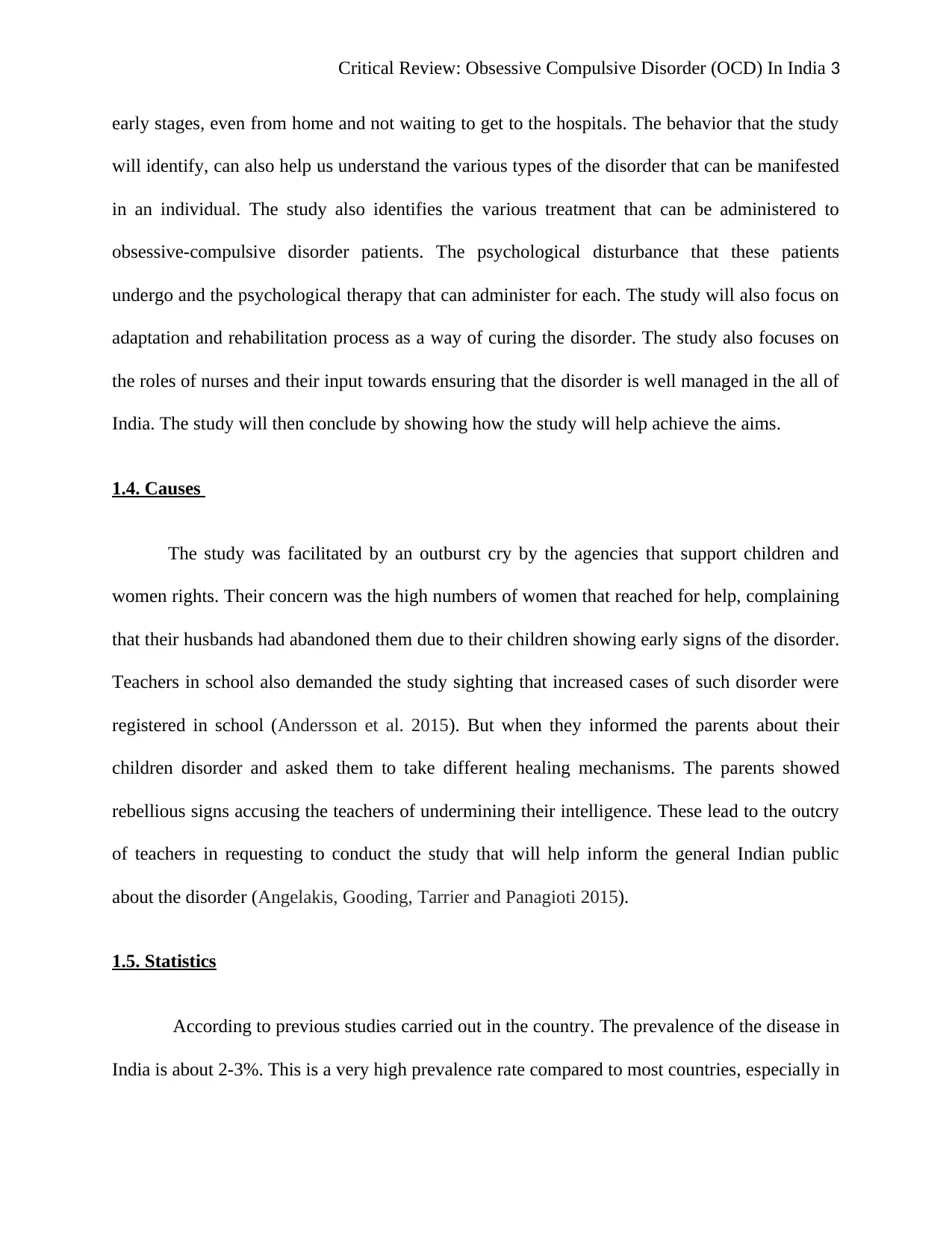
Critical Review: Obsessive Compulsive Disorder (OCD) In India 3
early stages, even from home and not waiting to get to the hospitals. The behavior that the study
will identify, can also help us understand the various types of the disorder that can be manifested
in an individual. The study also identifies the various treatment that can be administered to
obsessive-compulsive disorder patients. The psychological disturbance that these patients
undergo and the psychological therapy that can administer for each. The study will also focus on
adaptation and rehabilitation process as a way of curing the disorder. The study also focuses on
the roles of nurses and their input towards ensuring that the disorder is well managed in the all of
India. The study will then conclude by showing how the study will help achieve the aims.
1.4. Causes
The study was facilitated by an outburst cry by the agencies that support children and
women rights. Their concern was the high numbers of women that reached for help, complaining
that their husbands had abandoned them due to their children showing early signs of the disorder.
Teachers in school also demanded the study sighting that increased cases of such disorder were
registered in school (Andersson et al. 2015). But when they informed the parents about their
children disorder and asked them to take different healing mechanisms. The parents showed
rebellious signs accusing the teachers of undermining their intelligence. These lead to the outcry
of teachers in requesting to conduct the study that will help inform the general Indian public
about the disorder (Angelakis, Gooding, Tarrier and Panagioti 2015).
1.5. Statistics
According to previous studies carried out in the country. The prevalence of the disease in
India is about 2-3%. This is a very high prevalence rate compared to most countries, especially in
early stages, even from home and not waiting to get to the hospitals. The behavior that the study
will identify, can also help us understand the various types of the disorder that can be manifested
in an individual. The study also identifies the various treatment that can be administered to
obsessive-compulsive disorder patients. The psychological disturbance that these patients
undergo and the psychological therapy that can administer for each. The study will also focus on
adaptation and rehabilitation process as a way of curing the disorder. The study also focuses on
the roles of nurses and their input towards ensuring that the disorder is well managed in the all of
India. The study will then conclude by showing how the study will help achieve the aims.
1.4. Causes
The study was facilitated by an outburst cry by the agencies that support children and
women rights. Their concern was the high numbers of women that reached for help, complaining
that their husbands had abandoned them due to their children showing early signs of the disorder.
Teachers in school also demanded the study sighting that increased cases of such disorder were
registered in school (Andersson et al. 2015). But when they informed the parents about their
children disorder and asked them to take different healing mechanisms. The parents showed
rebellious signs accusing the teachers of undermining their intelligence. These lead to the outcry
of teachers in requesting to conduct the study that will help inform the general Indian public
about the disorder (Angelakis, Gooding, Tarrier and Panagioti 2015).
1.5. Statistics
According to previous studies carried out in the country. The prevalence of the disease in
India is about 2-3%. This is a very high prevalence rate compared to most countries, especially in
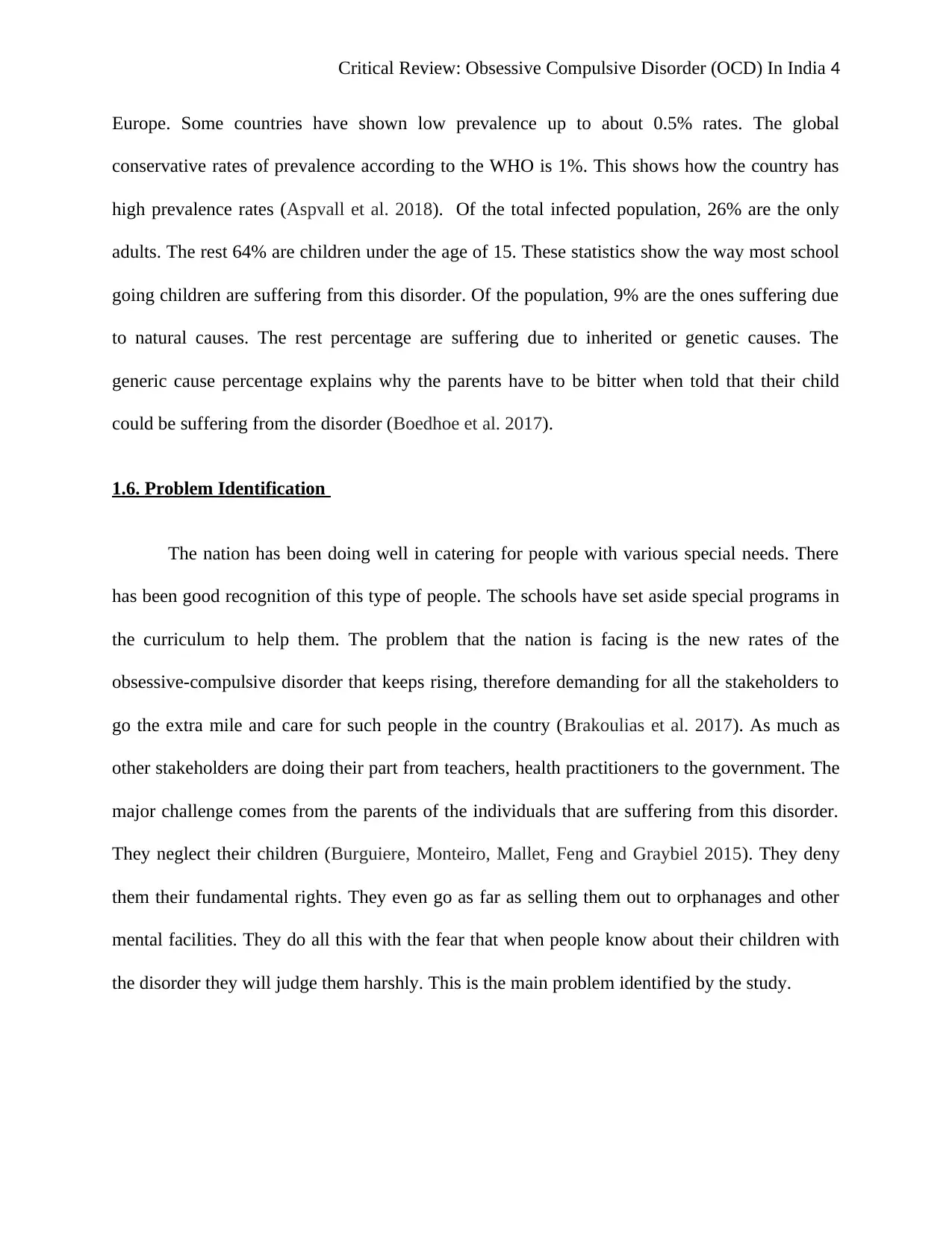
Critical Review: Obsessive Compulsive Disorder (OCD) In India 4
Europe. Some countries have shown low prevalence up to about 0.5% rates. The global
conservative rates of prevalence according to the WHO is 1%. This shows how the country has
high prevalence rates (Aspvall et al. 2018). Of the total infected population, 26% are the only
adults. The rest 64% are children under the age of 15. These statistics show the way most school
going children are suffering from this disorder. Of the population, 9% are the ones suffering due
to natural causes. The rest percentage are suffering due to inherited or genetic causes. The
generic cause percentage explains why the parents have to be bitter when told that their child
could be suffering from the disorder (Boedhoe et al. 2017).
1.6. Problem Identification
The nation has been doing well in catering for people with various special needs. There
has been good recognition of this type of people. The schools have set aside special programs in
the curriculum to help them. The problem that the nation is facing is the new rates of the
obsessive-compulsive disorder that keeps rising, therefore demanding for all the stakeholders to
go the extra mile and care for such people in the country (Brakoulias et al. 2017). As much as
other stakeholders are doing their part from teachers, health practitioners to the government. The
major challenge comes from the parents of the individuals that are suffering from this disorder.
They neglect their children (Burguiere, Monteiro, Mallet, Feng and Graybiel 2015). They deny
them their fundamental rights. They even go as far as selling them out to orphanages and other
mental facilities. They do all this with the fear that when people know about their children with
the disorder they will judge them harshly. This is the main problem identified by the study.
Europe. Some countries have shown low prevalence up to about 0.5% rates. The global
conservative rates of prevalence according to the WHO is 1%. This shows how the country has
high prevalence rates (Aspvall et al. 2018). Of the total infected population, 26% are the only
adults. The rest 64% are children under the age of 15. These statistics show the way most school
going children are suffering from this disorder. Of the population, 9% are the ones suffering due
to natural causes. The rest percentage are suffering due to inherited or genetic causes. The
generic cause percentage explains why the parents have to be bitter when told that their child
could be suffering from the disorder (Boedhoe et al. 2017).
1.6. Problem Identification
The nation has been doing well in catering for people with various special needs. There
has been good recognition of this type of people. The schools have set aside special programs in
the curriculum to help them. The problem that the nation is facing is the new rates of the
obsessive-compulsive disorder that keeps rising, therefore demanding for all the stakeholders to
go the extra mile and care for such people in the country (Brakoulias et al. 2017). As much as
other stakeholders are doing their part from teachers, health practitioners to the government. The
major challenge comes from the parents of the individuals that are suffering from this disorder.
They neglect their children (Burguiere, Monteiro, Mallet, Feng and Graybiel 2015). They deny
them their fundamental rights. They even go as far as selling them out to orphanages and other
mental facilities. They do all this with the fear that when people know about their children with
the disorder they will judge them harshly. This is the main problem identified by the study.
Secure Best Marks with AI Grader
Need help grading? Try our AI Grader for instant feedback on your assignments.
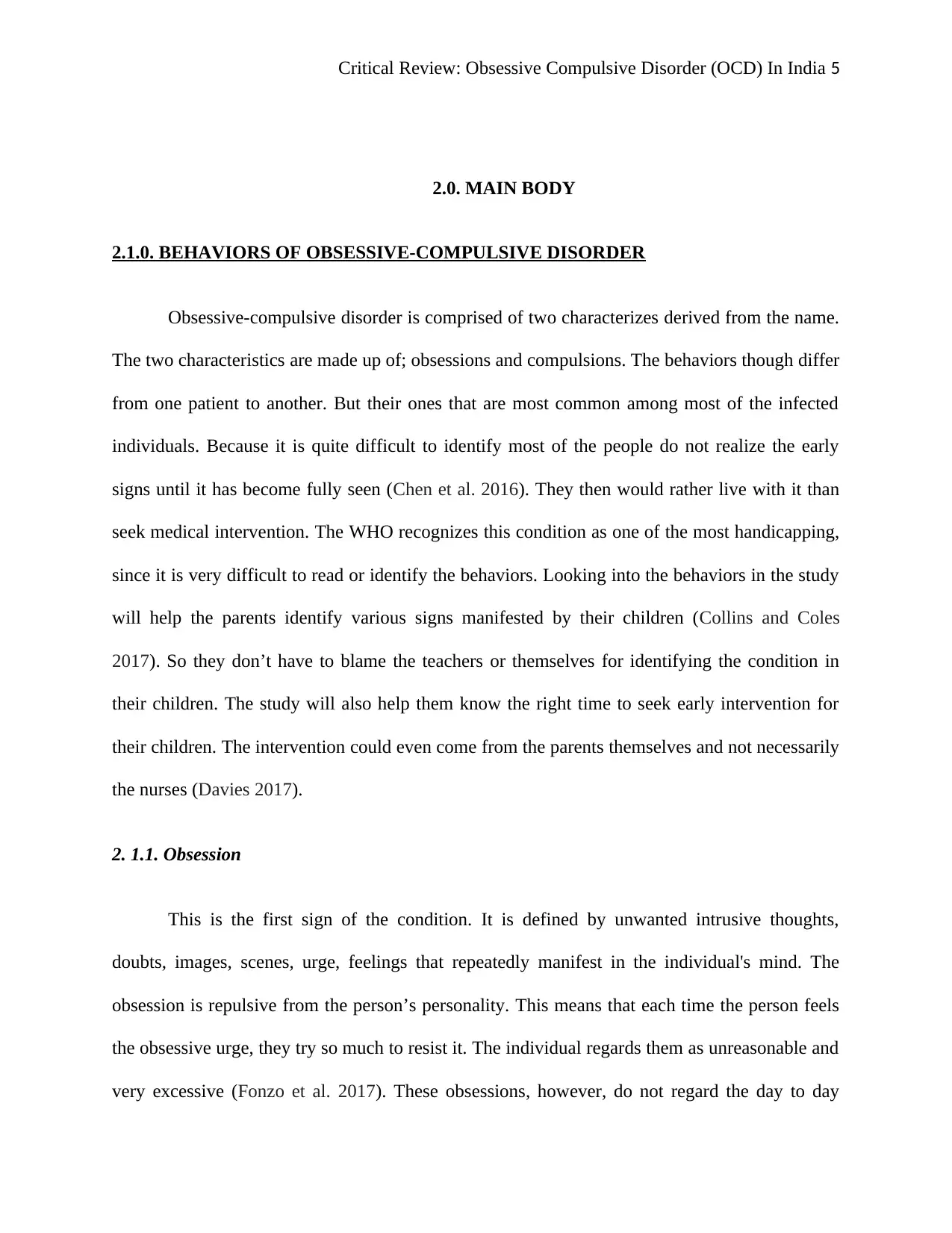
Critical Review: Obsessive Compulsive Disorder (OCD) In India 5
2.0. MAIN BODY
2.1.0. BEHAVIORS OF OBSESSIVE-COMPULSIVE DISORDER
Obsessive-compulsive disorder is comprised of two characterizes derived from the name.
The two characteristics are made up of; obsessions and compulsions. The behaviors though differ
from one patient to another. But their ones that are most common among most of the infected
individuals. Because it is quite difficult to identify most of the people do not realize the early
signs until it has become fully seen (Chen et al. 2016). They then would rather live with it than
seek medical intervention. The WHO recognizes this condition as one of the most handicapping,
since it is very difficult to read or identify the behaviors. Looking into the behaviors in the study
will help the parents identify various signs manifested by their children (Collins and Coles
2017). So they don’t have to blame the teachers or themselves for identifying the condition in
their children. The study will also help them know the right time to seek early intervention for
their children. The intervention could even come from the parents themselves and not necessarily
the nurses (Davies 2017).
2. 1.1. Obsession
This is the first sign of the condition. It is defined by unwanted intrusive thoughts,
doubts, images, scenes, urge, feelings that repeatedly manifest in the individual's mind. The
obsession is repulsive from the person’s personality. This means that each time the person feels
the obsessive urge, they try so much to resist it. The individual regards them as unreasonable and
very excessive (Fonzo et al. 2017). These obsessions, however, do not regard the day to day
2.0. MAIN BODY
2.1.0. BEHAVIORS OF OBSESSIVE-COMPULSIVE DISORDER
Obsessive-compulsive disorder is comprised of two characterizes derived from the name.
The two characteristics are made up of; obsessions and compulsions. The behaviors though differ
from one patient to another. But their ones that are most common among most of the infected
individuals. Because it is quite difficult to identify most of the people do not realize the early
signs until it has become fully seen (Chen et al. 2016). They then would rather live with it than
seek medical intervention. The WHO recognizes this condition as one of the most handicapping,
since it is very difficult to read or identify the behaviors. Looking into the behaviors in the study
will help the parents identify various signs manifested by their children (Collins and Coles
2017). So they don’t have to blame the teachers or themselves for identifying the condition in
their children. The study will also help them know the right time to seek early intervention for
their children. The intervention could even come from the parents themselves and not necessarily
the nurses (Davies 2017).
2. 1.1. Obsession
This is the first sign of the condition. It is defined by unwanted intrusive thoughts,
doubts, images, scenes, urge, feelings that repeatedly manifest in the individual's mind. The
obsession is repulsive from the person’s personality. This means that each time the person feels
the obsessive urge, they try so much to resist it. The individual regards them as unreasonable and
very excessive (Fonzo et al. 2017). These obsessions, however, do not regard the day to day
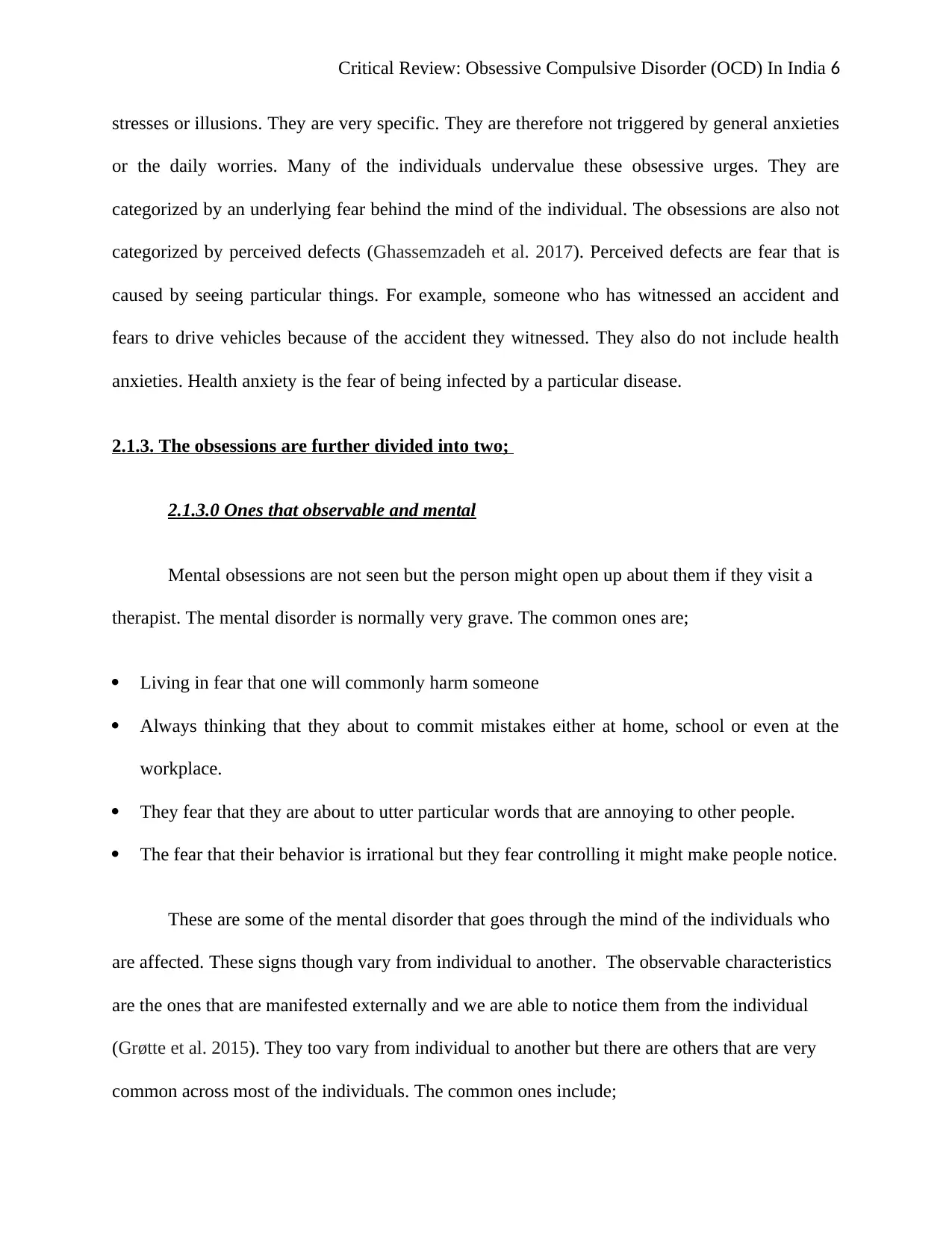
Critical Review: Obsessive Compulsive Disorder (OCD) In India 6
stresses or illusions. They are very specific. They are therefore not triggered by general anxieties
or the daily worries. Many of the individuals undervalue these obsessive urges. They are
categorized by an underlying fear behind the mind of the individual. The obsessions are also not
categorized by perceived defects (Ghassemzadeh et al. 2017). Perceived defects are fear that is
caused by seeing particular things. For example, someone who has witnessed an accident and
fears to drive vehicles because of the accident they witnessed. They also do not include health
anxieties. Health anxiety is the fear of being infected by a particular disease.
2.1.3. The obsessions are further divided into two;
2.1.3.0 Ones that observable and mental
Mental obsessions are not seen but the person might open up about them if they visit a
therapist. The mental disorder is normally very grave. The common ones are;
Living in fear that one will commonly harm someone
Always thinking that they about to commit mistakes either at home, school or even at the
workplace.
They fear that they are about to utter particular words that are annoying to other people.
The fear that their behavior is irrational but they fear controlling it might make people notice.
These are some of the mental disorder that goes through the mind of the individuals who
are affected. These signs though vary from individual to another. The observable characteristics
are the ones that are manifested externally and we are able to notice them from the individual
(Grøtte et al. 2015). They too vary from individual to another but there are others that are very
common across most of the individuals. The common ones include;
stresses or illusions. They are very specific. They are therefore not triggered by general anxieties
or the daily worries. Many of the individuals undervalue these obsessive urges. They are
categorized by an underlying fear behind the mind of the individual. The obsessions are also not
categorized by perceived defects (Ghassemzadeh et al. 2017). Perceived defects are fear that is
caused by seeing particular things. For example, someone who has witnessed an accident and
fears to drive vehicles because of the accident they witnessed. They also do not include health
anxieties. Health anxiety is the fear of being infected by a particular disease.
2.1.3. The obsessions are further divided into two;
2.1.3.0 Ones that observable and mental
Mental obsessions are not seen but the person might open up about them if they visit a
therapist. The mental disorder is normally very grave. The common ones are;
Living in fear that one will commonly harm someone
Always thinking that they about to commit mistakes either at home, school or even at the
workplace.
They fear that they are about to utter particular words that are annoying to other people.
The fear that their behavior is irrational but they fear controlling it might make people notice.
These are some of the mental disorder that goes through the mind of the individuals who
are affected. These signs though vary from individual to another. The observable characteristics
are the ones that are manifested externally and we are able to notice them from the individual
(Grøtte et al. 2015). They too vary from individual to another but there are others that are very
common across most of the individuals. The common ones include;
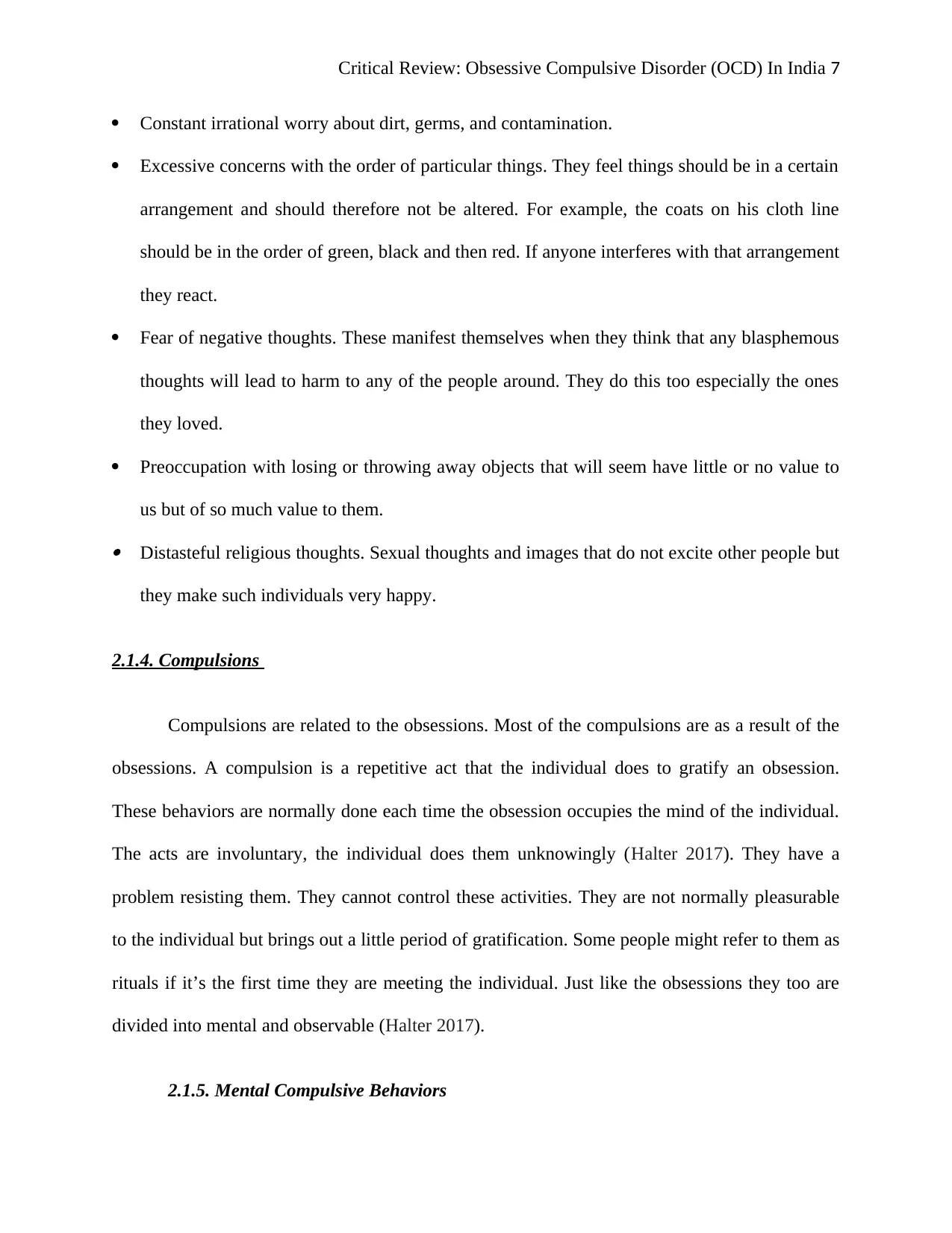
Critical Review: Obsessive Compulsive Disorder (OCD) In India 7
Constant irrational worry about dirt, germs, and contamination.
Excessive concerns with the order of particular things. They feel things should be in a certain
arrangement and should therefore not be altered. For example, the coats on his cloth line
should be in the order of green, black and then red. If anyone interferes with that arrangement
they react.
Fear of negative thoughts. These manifest themselves when they think that any blasphemous
thoughts will lead to harm to any of the people around. They do this too especially the ones
they loved.
Preoccupation with losing or throwing away objects that will seem have little or no value to
us but of so much value to them.
Distasteful religious thoughts. Sexual thoughts and images that do not excite other people but
they make such individuals very happy.
2.1.4. Compulsions
Compulsions are related to the obsessions. Most of the compulsions are as a result of the
obsessions. A compulsion is a repetitive act that the individual does to gratify an obsession.
These behaviors are normally done each time the obsession occupies the mind of the individual.
The acts are involuntary, the individual does them unknowingly (Halter 2017). They have a
problem resisting them. They cannot control these activities. They are not normally pleasurable
to the individual but brings out a little period of gratification. Some people might refer to them as
rituals if it’s the first time they are meeting the individual. Just like the obsessions they too are
divided into mental and observable (Halter 2017).
2.1.5. Mental Compulsive Behaviors
Constant irrational worry about dirt, germs, and contamination.
Excessive concerns with the order of particular things. They feel things should be in a certain
arrangement and should therefore not be altered. For example, the coats on his cloth line
should be in the order of green, black and then red. If anyone interferes with that arrangement
they react.
Fear of negative thoughts. These manifest themselves when they think that any blasphemous
thoughts will lead to harm to any of the people around. They do this too especially the ones
they loved.
Preoccupation with losing or throwing away objects that will seem have little or no value to
us but of so much value to them.
Distasteful religious thoughts. Sexual thoughts and images that do not excite other people but
they make such individuals very happy.
2.1.4. Compulsions
Compulsions are related to the obsessions. Most of the compulsions are as a result of the
obsessions. A compulsion is a repetitive act that the individual does to gratify an obsession.
These behaviors are normally done each time the obsession occupies the mind of the individual.
The acts are involuntary, the individual does them unknowingly (Halter 2017). They have a
problem resisting them. They cannot control these activities. They are not normally pleasurable
to the individual but brings out a little period of gratification. Some people might refer to them as
rituals if it’s the first time they are meeting the individual. Just like the obsessions they too are
divided into mental and observable (Halter 2017).
2.1.5. Mental Compulsive Behaviors
Paraphrase This Document
Need a fresh take? Get an instant paraphrase of this document with our AI Paraphraser
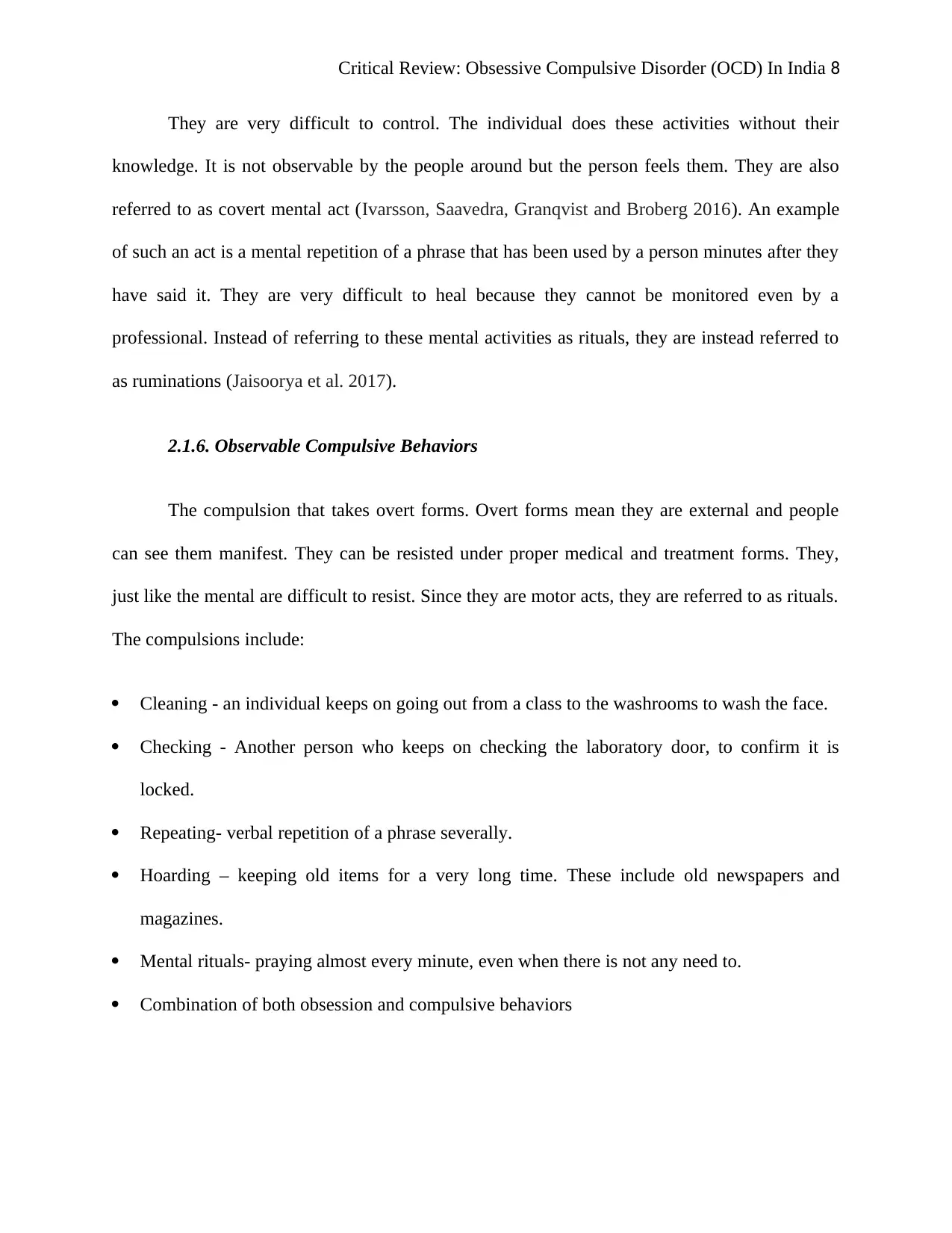
Critical Review: Obsessive Compulsive Disorder (OCD) In India 8
They are very difficult to control. The individual does these activities without their
knowledge. It is not observable by the people around but the person feels them. They are also
referred to as covert mental act (Ivarsson, Saavedra, Granqvist and Broberg 2016). An example
of such an act is a mental repetition of a phrase that has been used by a person minutes after they
have said it. They are very difficult to heal because they cannot be monitored even by a
professional. Instead of referring to these mental activities as rituals, they are instead referred to
as ruminations (Jaisoorya et al. 2017).
2.1.6. Observable Compulsive Behaviors
The compulsion that takes overt forms. Overt forms mean they are external and people
can see them manifest. They can be resisted under proper medical and treatment forms. They,
just like the mental are difficult to resist. Since they are motor acts, they are referred to as rituals.
The compulsions include:
Cleaning - an individual keeps on going out from a class to the washrooms to wash the face.
Checking - Another person who keeps on checking the laboratory door, to confirm it is
locked.
Repeating- verbal repetition of a phrase severally.
Hoarding – keeping old items for a very long time. These include old newspapers and
magazines.
Mental rituals- praying almost every minute, even when there is not any need to.
Combination of both obsession and compulsive behaviors
They are very difficult to control. The individual does these activities without their
knowledge. It is not observable by the people around but the person feels them. They are also
referred to as covert mental act (Ivarsson, Saavedra, Granqvist and Broberg 2016). An example
of such an act is a mental repetition of a phrase that has been used by a person minutes after they
have said it. They are very difficult to heal because they cannot be monitored even by a
professional. Instead of referring to these mental activities as rituals, they are instead referred to
as ruminations (Jaisoorya et al. 2017).
2.1.6. Observable Compulsive Behaviors
The compulsion that takes overt forms. Overt forms mean they are external and people
can see them manifest. They can be resisted under proper medical and treatment forms. They,
just like the mental are difficult to resist. Since they are motor acts, they are referred to as rituals.
The compulsions include:
Cleaning - an individual keeps on going out from a class to the washrooms to wash the face.
Checking - Another person who keeps on checking the laboratory door, to confirm it is
locked.
Repeating- verbal repetition of a phrase severally.
Hoarding – keeping old items for a very long time. These include old newspapers and
magazines.
Mental rituals- praying almost every minute, even when there is not any need to.
Combination of both obsession and compulsive behaviors

Critical Review: Obsessive Compulsive Disorder (OCD) In India 9
These are thoughts that hit the individual and then he immediately follows with a ritual or
an activity that is compulsive. The obsession compulsive behaviors normally take more than an
hour in a day (Jaisoorya, Reddy, Thennarasu, Beena, Beena and Jose 2015). The obsession
consumes the individual and takes a better part of their day. The compulsions could be very
difficult to identify if they are stigmatized. The individual will hide the behavior if they think the
behavior is so shameful. When they hide it can be very difficult to diagnose the individual of the
condition (Kameg, Richardson and Szpak 2015). The people observing such individuals should,
therefore, open up to them so that they don’t feel intrusive.
The following cycle can be used to explain what goes on in an individual who has
obsessive-compulsive disorders. The cycle is developed from the systems of the disorders,
Obsessive thought …………… anxiety…………..compulsive behavior …………………
gratification and temporary relief.
2.1.7. Diagnosing the Condition
The following questions were developed to help one in identifying if they or another
person are suffering from the condition. The question can be tested anywhere without having to
search for an expert.
Does the person affected wash or clean a lot
Does the person check things a lot, even the simple things?
Is there any thought that keeps bothering the individual that the individual feels they cannot
rid of?
Does the person take a long time to clear their daily activities?
These are thoughts that hit the individual and then he immediately follows with a ritual or
an activity that is compulsive. The obsession compulsive behaviors normally take more than an
hour in a day (Jaisoorya, Reddy, Thennarasu, Beena, Beena and Jose 2015). The obsession
consumes the individual and takes a better part of their day. The compulsions could be very
difficult to identify if they are stigmatized. The individual will hide the behavior if they think the
behavior is so shameful. When they hide it can be very difficult to diagnose the individual of the
condition (Kameg, Richardson and Szpak 2015). The people observing such individuals should,
therefore, open up to them so that they don’t feel intrusive.
The following cycle can be used to explain what goes on in an individual who has
obsessive-compulsive disorders. The cycle is developed from the systems of the disorders,
Obsessive thought …………… anxiety…………..compulsive behavior …………………
gratification and temporary relief.
2.1.7. Diagnosing the Condition
The following questions were developed to help one in identifying if they or another
person are suffering from the condition. The question can be tested anywhere without having to
search for an expert.
Does the person affected wash or clean a lot
Does the person check things a lot, even the simple things?
Is there any thought that keeps bothering the individual that the individual feels they cannot
rid of?
Does the person take a long time to clear their daily activities?

Critical Review: Obsessive Compulsive Disorder (OCD) In India 10
Is the individual concerned about a special order? They feel that the order should not be
changed whatsoever.
If the issues that have been discussed are affecting the mental stature of the individual.
These questions not only help discover if one is really suffering from the condition. But
also helps in determining the extent to which the condition is. The condition could mild,
moderate or severe (Koujalgi, Nayak, Pandurangi and Patil 2015). Other conditions that could be
related to OCD. The conditions include depression, social phobia, excessive use of alcohol
(especially for adults) and other anxieties.
2.2.0. TREATMENT OPTION
2.2.1. Drug Medication
The drug treatment for this condition is Serotonin reuptake inhibitors. The drugs are
referred to as SRI in its short form. This is the first line of drug treatment normally administered
to such patients. The drugs were introduced in the late 80s. They were initially used for treating
depression but later proved worth it in treating OCD condition. Presently it is developed into five
other forms (Lissemore, Nordahl and Benkelfat 2015). The five forms are fluoxetine, paroxetine,
fluvoxamine, sertraline, and citalopram.
Though some doctors have tried anxiety and depression drugs for OCD it has never
worked. This proves that the best medication for OCD is the SRI. It is not scientifically clear
how SRI works to cure this disease. Some earlier theories explain that the drug causes a decrease
in neurotransmission. Therefore as the patient receives the mental obsession, the drug slows
down the effect (Mattheisen et al. 2015). The patient will not, therefore, perform the ritual. This
Is the individual concerned about a special order? They feel that the order should not be
changed whatsoever.
If the issues that have been discussed are affecting the mental stature of the individual.
These questions not only help discover if one is really suffering from the condition. But
also helps in determining the extent to which the condition is. The condition could mild,
moderate or severe (Koujalgi, Nayak, Pandurangi and Patil 2015). Other conditions that could be
related to OCD. The conditions include depression, social phobia, excessive use of alcohol
(especially for adults) and other anxieties.
2.2.0. TREATMENT OPTION
2.2.1. Drug Medication
The drug treatment for this condition is Serotonin reuptake inhibitors. The drugs are
referred to as SRI in its short form. This is the first line of drug treatment normally administered
to such patients. The drugs were introduced in the late 80s. They were initially used for treating
depression but later proved worth it in treating OCD condition. Presently it is developed into five
other forms (Lissemore, Nordahl and Benkelfat 2015). The five forms are fluoxetine, paroxetine,
fluvoxamine, sertraline, and citalopram.
Though some doctors have tried anxiety and depression drugs for OCD it has never
worked. This proves that the best medication for OCD is the SRI. It is not scientifically clear
how SRI works to cure this disease. Some earlier theories explain that the drug causes a decrease
in neurotransmission. Therefore as the patient receives the mental obsession, the drug slows
down the effect (Mattheisen et al. 2015). The patient will not, therefore, perform the ritual. This
Secure Best Marks with AI Grader
Need help grading? Try our AI Grader for instant feedback on your assignments.
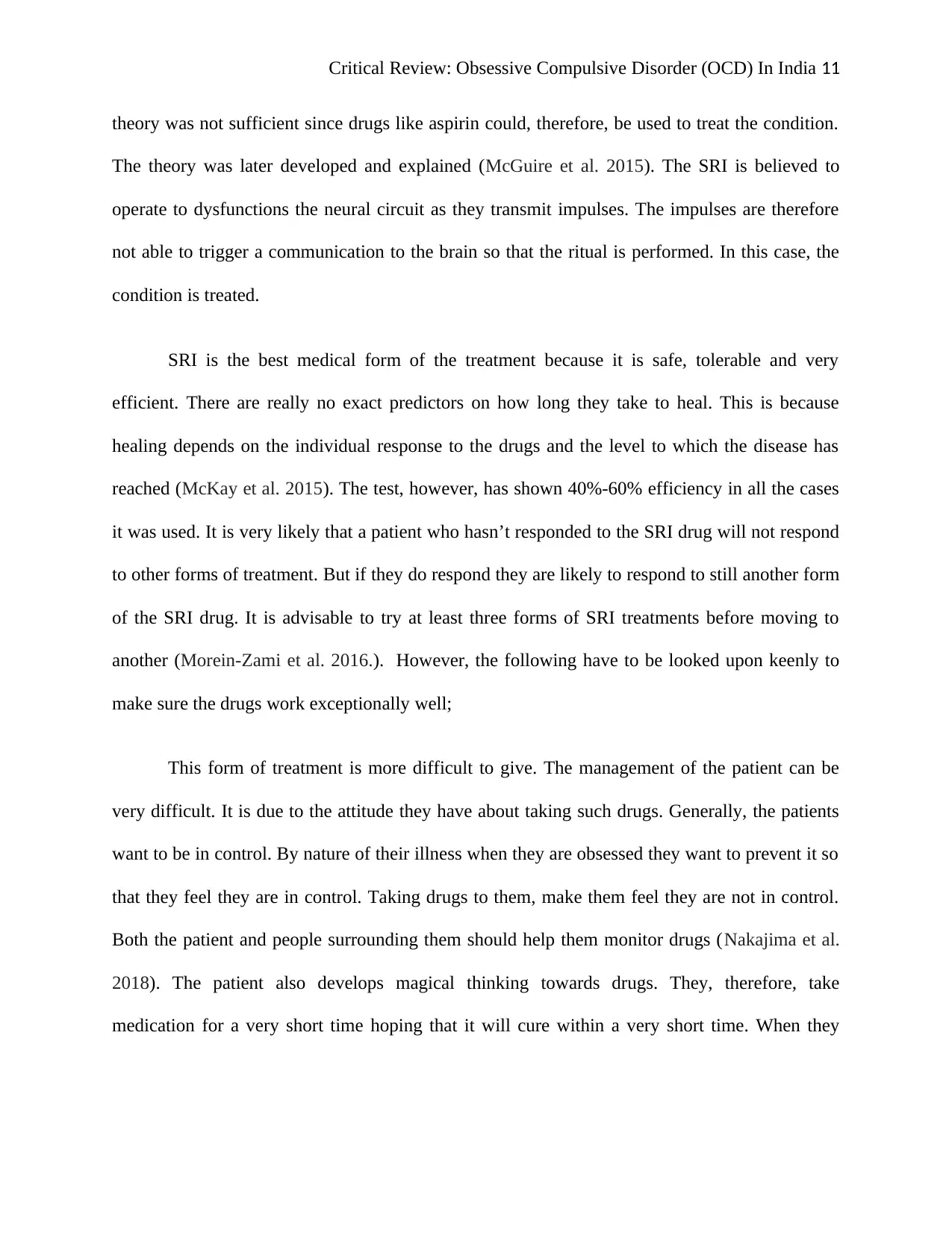
Critical Review: Obsessive Compulsive Disorder (OCD) In India 11
theory was not sufficient since drugs like aspirin could, therefore, be used to treat the condition.
The theory was later developed and explained (McGuire et al. 2015). The SRI is believed to
operate to dysfunctions the neural circuit as they transmit impulses. The impulses are therefore
not able to trigger a communication to the brain so that the ritual is performed. In this case, the
condition is treated.
SRI is the best medical form of the treatment because it is safe, tolerable and very
efficient. There are really no exact predictors on how long they take to heal. This is because
healing depends on the individual response to the drugs and the level to which the disease has
reached (McKay et al. 2015). The test, however, has shown 40%-60% efficiency in all the cases
it was used. It is very likely that a patient who hasn’t responded to the SRI drug will not respond
to other forms of treatment. But if they do respond they are likely to respond to still another form
of the SRI drug. It is advisable to try at least three forms of SRI treatments before moving to
another (Morein-Zami et al. 2016.). However, the following have to be looked upon keenly to
make sure the drugs work exceptionally well;
This form of treatment is more difficult to give. The management of the patient can be
very difficult. It is due to the attitude they have about taking such drugs. Generally, the patients
want to be in control. By nature of their illness when they are obsessed they want to prevent it so
that they feel they are in control. Taking drugs to them, make them feel they are not in control.
Both the patient and people surrounding them should help them monitor drugs (Nakajima et al.
2018). The patient also develops magical thinking towards drugs. They, therefore, take
medication for a very short time hoping that it will cure within a very short time. When they
theory was not sufficient since drugs like aspirin could, therefore, be used to treat the condition.
The theory was later developed and explained (McGuire et al. 2015). The SRI is believed to
operate to dysfunctions the neural circuit as they transmit impulses. The impulses are therefore
not able to trigger a communication to the brain so that the ritual is performed. In this case, the
condition is treated.
SRI is the best medical form of the treatment because it is safe, tolerable and very
efficient. There are really no exact predictors on how long they take to heal. This is because
healing depends on the individual response to the drugs and the level to which the disease has
reached (McKay et al. 2015). The test, however, has shown 40%-60% efficiency in all the cases
it was used. It is very likely that a patient who hasn’t responded to the SRI drug will not respond
to other forms of treatment. But if they do respond they are likely to respond to still another form
of the SRI drug. It is advisable to try at least three forms of SRI treatments before moving to
another (Morein-Zami et al. 2016.). However, the following have to be looked upon keenly to
make sure the drugs work exceptionally well;
This form of treatment is more difficult to give. The management of the patient can be
very difficult. It is due to the attitude they have about taking such drugs. Generally, the patients
want to be in control. By nature of their illness when they are obsessed they want to prevent it so
that they feel they are in control. Taking drugs to them, make them feel they are not in control.
Both the patient and people surrounding them should help them monitor drugs (Nakajima et al.
2018). The patient also develops magical thinking towards drugs. They, therefore, take
medication for a very short time hoping that it will cure within a very short time. When they
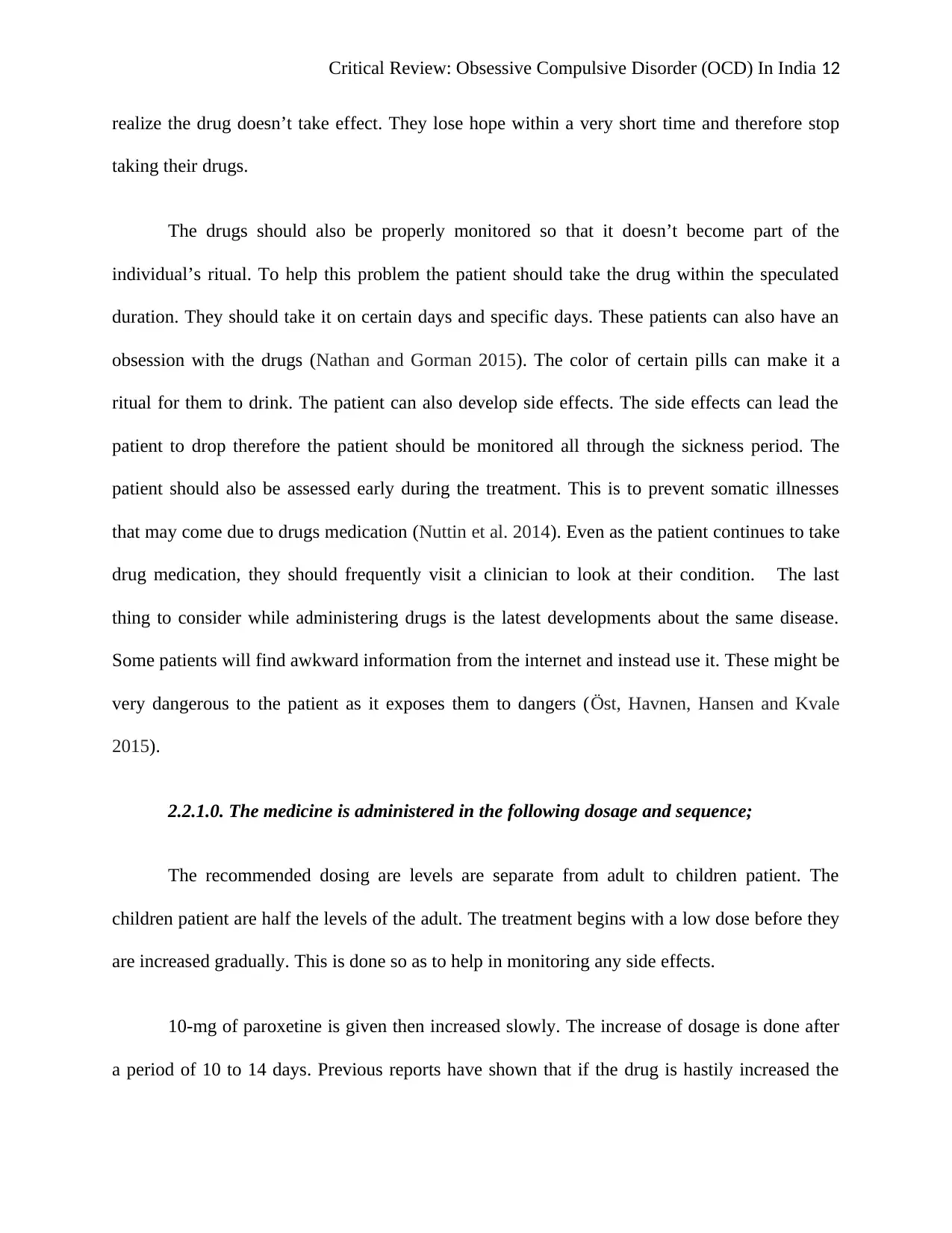
Critical Review: Obsessive Compulsive Disorder (OCD) In India 12
realize the drug doesn’t take effect. They lose hope within a very short time and therefore stop
taking their drugs.
The drugs should also be properly monitored so that it doesn’t become part of the
individual’s ritual. To help this problem the patient should take the drug within the speculated
duration. They should take it on certain days and specific days. These patients can also have an
obsession with the drugs (Nathan and Gorman 2015). The color of certain pills can make it a
ritual for them to drink. The patient can also develop side effects. The side effects can lead the
patient to drop therefore the patient should be monitored all through the sickness period. The
patient should also be assessed early during the treatment. This is to prevent somatic illnesses
that may come due to drugs medication (Nuttin et al. 2014). Even as the patient continues to take
drug medication, they should frequently visit a clinician to look at their condition. The last
thing to consider while administering drugs is the latest developments about the same disease.
Some patients will find awkward information from the internet and instead use it. These might be
very dangerous to the patient as it exposes them to dangers (Öst, Havnen, Hansen and Kvale
2015).
2.2.1.0. The medicine is administered in the following dosage and sequence;
The recommended dosing are levels are separate from adult to children patient. The
children patient are half the levels of the adult. The treatment begins with a low dose before they
are increased gradually. This is done so as to help in monitoring any side effects.
10-mg of paroxetine is given then increased slowly. The increase of dosage is done after
a period of 10 to 14 days. Previous reports have shown that if the drug is hastily increased the
realize the drug doesn’t take effect. They lose hope within a very short time and therefore stop
taking their drugs.
The drugs should also be properly monitored so that it doesn’t become part of the
individual’s ritual. To help this problem the patient should take the drug within the speculated
duration. They should take it on certain days and specific days. These patients can also have an
obsession with the drugs (Nathan and Gorman 2015). The color of certain pills can make it a
ritual for them to drink. The patient can also develop side effects. The side effects can lead the
patient to drop therefore the patient should be monitored all through the sickness period. The
patient should also be assessed early during the treatment. This is to prevent somatic illnesses
that may come due to drugs medication (Nuttin et al. 2014). Even as the patient continues to take
drug medication, they should frequently visit a clinician to look at their condition. The last
thing to consider while administering drugs is the latest developments about the same disease.
Some patients will find awkward information from the internet and instead use it. These might be
very dangerous to the patient as it exposes them to dangers (Öst, Havnen, Hansen and Kvale
2015).
2.2.1.0. The medicine is administered in the following dosage and sequence;
The recommended dosing are levels are separate from adult to children patient. The
children patient are half the levels of the adult. The treatment begins with a low dose before they
are increased gradually. This is done so as to help in monitoring any side effects.
10-mg of paroxetine is given then increased slowly. The increase of dosage is done after
a period of 10 to 14 days. Previous reports have shown that if the drug is hastily increased the
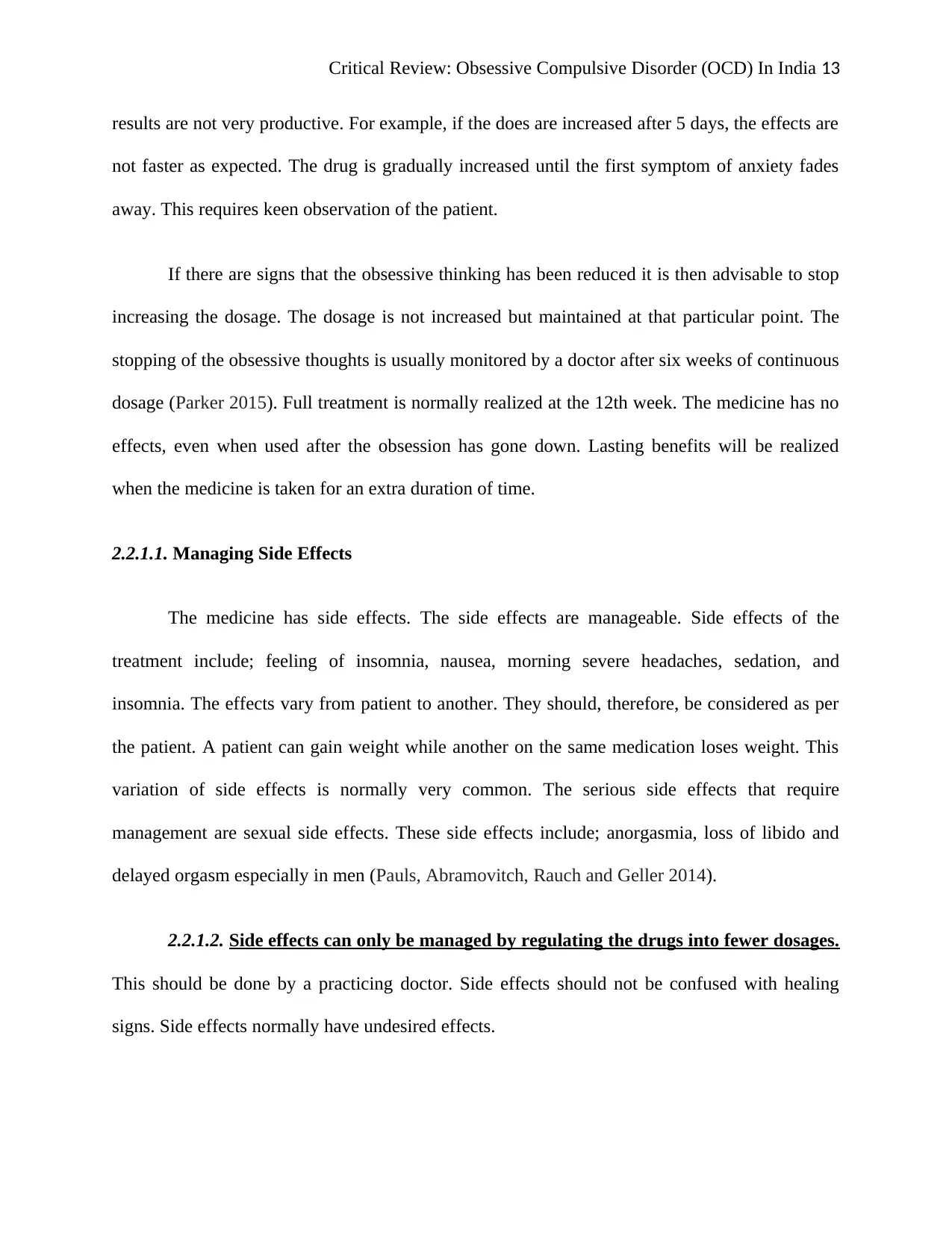
Critical Review: Obsessive Compulsive Disorder (OCD) In India 13
results are not very productive. For example, if the does are increased after 5 days, the effects are
not faster as expected. The drug is gradually increased until the first symptom of anxiety fades
away. This requires keen observation of the patient.
If there are signs that the obsessive thinking has been reduced it is then advisable to stop
increasing the dosage. The dosage is not increased but maintained at that particular point. The
stopping of the obsessive thoughts is usually monitored by a doctor after six weeks of continuous
dosage (Parker 2015). Full treatment is normally realized at the 12th week. The medicine has no
effects, even when used after the obsession has gone down. Lasting benefits will be realized
when the medicine is taken for an extra duration of time.
2.2.1.1. Managing Side Effects
The medicine has side effects. The side effects are manageable. Side effects of the
treatment include; feeling of insomnia, nausea, morning severe headaches, sedation, and
insomnia. The effects vary from patient to another. They should, therefore, be considered as per
the patient. A patient can gain weight while another on the same medication loses weight. This
variation of side effects is normally very common. The serious side effects that require
management are sexual side effects. These side effects include; anorgasmia, loss of libido and
delayed orgasm especially in men (Pauls, Abramovitch, Rauch and Geller 2014).
2.2.1.2. Side effects can only be managed by regulating the drugs into fewer dosages.
This should be done by a practicing doctor. Side effects should not be confused with healing
signs. Side effects normally have undesired effects.
results are not very productive. For example, if the does are increased after 5 days, the effects are
not faster as expected. The drug is gradually increased until the first symptom of anxiety fades
away. This requires keen observation of the patient.
If there are signs that the obsessive thinking has been reduced it is then advisable to stop
increasing the dosage. The dosage is not increased but maintained at that particular point. The
stopping of the obsessive thoughts is usually monitored by a doctor after six weeks of continuous
dosage (Parker 2015). Full treatment is normally realized at the 12th week. The medicine has no
effects, even when used after the obsession has gone down. Lasting benefits will be realized
when the medicine is taken for an extra duration of time.
2.2.1.1. Managing Side Effects
The medicine has side effects. The side effects are manageable. Side effects of the
treatment include; feeling of insomnia, nausea, morning severe headaches, sedation, and
insomnia. The effects vary from patient to another. They should, therefore, be considered as per
the patient. A patient can gain weight while another on the same medication loses weight. This
variation of side effects is normally very common. The serious side effects that require
management are sexual side effects. These side effects include; anorgasmia, loss of libido and
delayed orgasm especially in men (Pauls, Abramovitch, Rauch and Geller 2014).
2.2.1.2. Side effects can only be managed by regulating the drugs into fewer dosages.
This should be done by a practicing doctor. Side effects should not be confused with healing
signs. Side effects normally have undesired effects.
Paraphrase This Document
Need a fresh take? Get an instant paraphrase of this document with our AI Paraphraser
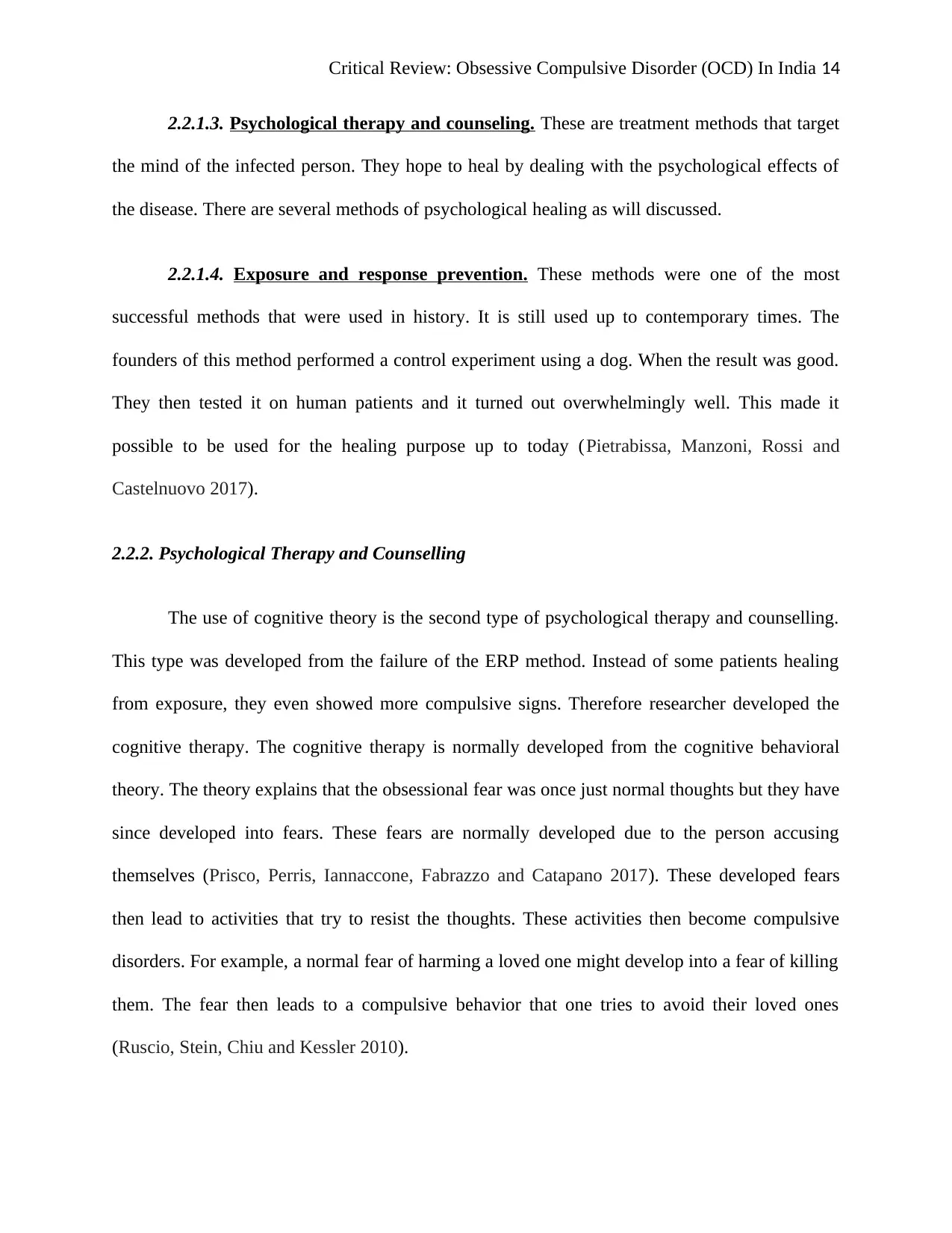
Critical Review: Obsessive Compulsive Disorder (OCD) In India 14
2.2.1.3. Psychological therapy and counseling. These are treatment methods that target
the mind of the infected person. They hope to heal by dealing with the psychological effects of
the disease. There are several methods of psychological healing as will discussed.
2.2.1.4. Exposure and response prevention. These methods were one of the most
successful methods that were used in history. It is still used up to contemporary times. The
founders of this method performed a control experiment using a dog. When the result was good.
They then tested it on human patients and it turned out overwhelmingly well. This made it
possible to be used for the healing purpose up to today (Pietrabissa, Manzoni, Rossi and
Castelnuovo 2017).
2.2.2. Psychological Therapy and Counselling
The use of cognitive theory is the second type of psychological therapy and counselling.
This type was developed from the failure of the ERP method. Instead of some patients healing
from exposure, they even showed more compulsive signs. Therefore researcher developed the
cognitive therapy. The cognitive therapy is normally developed from the cognitive behavioral
theory. The theory explains that the obsessional fear was once just normal thoughts but they have
since developed into fears. These fears are normally developed due to the person accusing
themselves (Prisco, Perris, Iannaccone, Fabrazzo and Catapano 2017). These developed fears
then lead to activities that try to resist the thoughts. These activities then become compulsive
disorders. For example, a normal fear of harming a loved one might develop into a fear of killing
them. The fear then leads to a compulsive behavior that one tries to avoid their loved ones
(Ruscio, Stein, Chiu and Kessler 2010).
2.2.1.3. Psychological therapy and counseling. These are treatment methods that target
the mind of the infected person. They hope to heal by dealing with the psychological effects of
the disease. There are several methods of psychological healing as will discussed.
2.2.1.4. Exposure and response prevention. These methods were one of the most
successful methods that were used in history. It is still used up to contemporary times. The
founders of this method performed a control experiment using a dog. When the result was good.
They then tested it on human patients and it turned out overwhelmingly well. This made it
possible to be used for the healing purpose up to today (Pietrabissa, Manzoni, Rossi and
Castelnuovo 2017).
2.2.2. Psychological Therapy and Counselling
The use of cognitive theory is the second type of psychological therapy and counselling.
This type was developed from the failure of the ERP method. Instead of some patients healing
from exposure, they even showed more compulsive signs. Therefore researcher developed the
cognitive therapy. The cognitive therapy is normally developed from the cognitive behavioral
theory. The theory explains that the obsessional fear was once just normal thoughts but they have
since developed into fears. These fears are normally developed due to the person accusing
themselves (Prisco, Perris, Iannaccone, Fabrazzo and Catapano 2017). These developed fears
then lead to activities that try to resist the thoughts. These activities then become compulsive
disorders. For example, a normal fear of harming a loved one might develop into a fear of killing
them. The fear then leads to a compulsive behavior that one tries to avoid their loved ones
(Ruscio, Stein, Chiu and Kessler 2010).
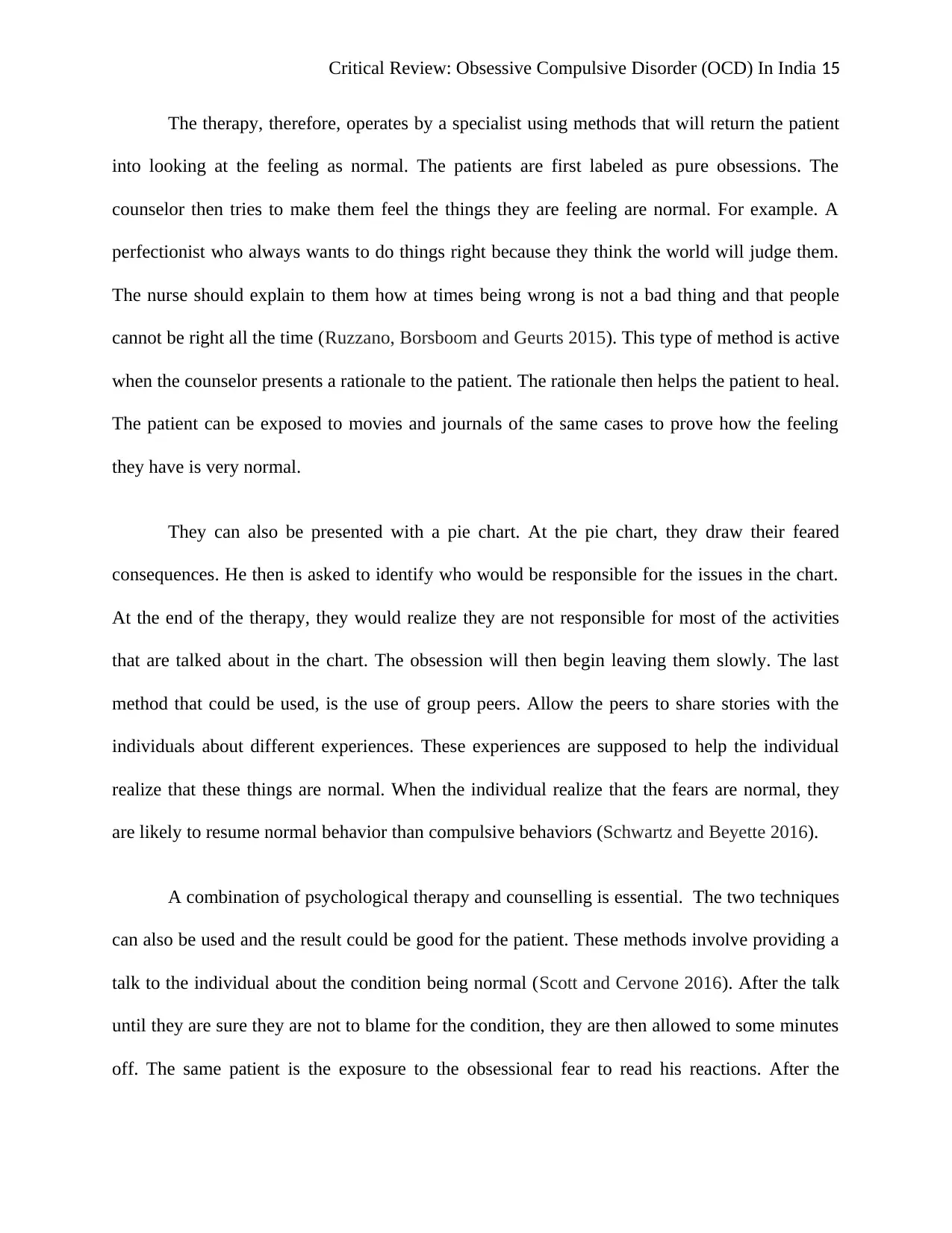
Critical Review: Obsessive Compulsive Disorder (OCD) In India 15
The therapy, therefore, operates by a specialist using methods that will return the patient
into looking at the feeling as normal. The patients are first labeled as pure obsessions. The
counselor then tries to make them feel the things they are feeling are normal. For example. A
perfectionist who always wants to do things right because they think the world will judge them.
The nurse should explain to them how at times being wrong is not a bad thing and that people
cannot be right all the time (Ruzzano, Borsboom and Geurts 2015). This type of method is active
when the counselor presents a rationale to the patient. The rationale then helps the patient to heal.
The patient can be exposed to movies and journals of the same cases to prove how the feeling
they have is very normal.
They can also be presented with a pie chart. At the pie chart, they draw their feared
consequences. He then is asked to identify who would be responsible for the issues in the chart.
At the end of the therapy, they would realize they are not responsible for most of the activities
that are talked about in the chart. The obsession will then begin leaving them slowly. The last
method that could be used, is the use of group peers. Allow the peers to share stories with the
individuals about different experiences. These experiences are supposed to help the individual
realize that these things are normal. When the individual realize that the fears are normal, they
are likely to resume normal behavior than compulsive behaviors (Schwartz and Beyette 2016).
A combination of psychological therapy and counselling is essential. The two techniques
can also be used and the result could be good for the patient. These methods involve providing a
talk to the individual about the condition being normal (Scott and Cervone 2016). After the talk
until they are sure they are not to blame for the condition, they are then allowed to some minutes
off. The same patient is the exposure to the obsessional fear to read his reactions. After the
The therapy, therefore, operates by a specialist using methods that will return the patient
into looking at the feeling as normal. The patients are first labeled as pure obsessions. The
counselor then tries to make them feel the things they are feeling are normal. For example. A
perfectionist who always wants to do things right because they think the world will judge them.
The nurse should explain to them how at times being wrong is not a bad thing and that people
cannot be right all the time (Ruzzano, Borsboom and Geurts 2015). This type of method is active
when the counselor presents a rationale to the patient. The rationale then helps the patient to heal.
The patient can be exposed to movies and journals of the same cases to prove how the feeling
they have is very normal.
They can also be presented with a pie chart. At the pie chart, they draw their feared
consequences. He then is asked to identify who would be responsible for the issues in the chart.
At the end of the therapy, they would realize they are not responsible for most of the activities
that are talked about in the chart. The obsession will then begin leaving them slowly. The last
method that could be used, is the use of group peers. Allow the peers to share stories with the
individuals about different experiences. These experiences are supposed to help the individual
realize that these things are normal. When the individual realize that the fears are normal, they
are likely to resume normal behavior than compulsive behaviors (Schwartz and Beyette 2016).
A combination of psychological therapy and counselling is essential. The two techniques
can also be used and the result could be good for the patient. These methods involve providing a
talk to the individual about the condition being normal (Scott and Cervone 2016). After the talk
until they are sure they are not to blame for the condition, they are then allowed to some minutes
off. The same patient is the exposure to the obsessional fear to read his reactions. After the
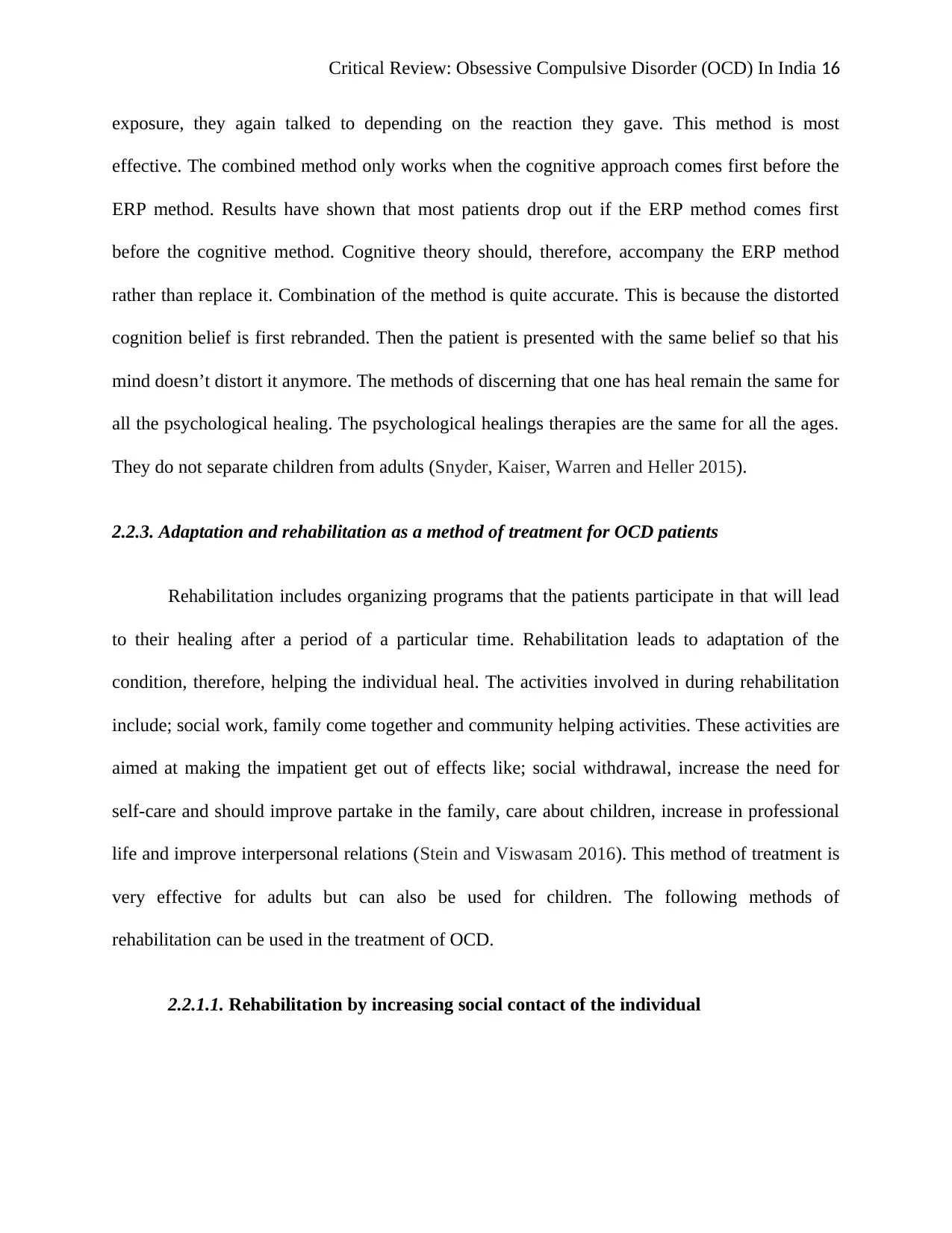
Critical Review: Obsessive Compulsive Disorder (OCD) In India 16
exposure, they again talked to depending on the reaction they gave. This method is most
effective. The combined method only works when the cognitive approach comes first before the
ERP method. Results have shown that most patients drop out if the ERP method comes first
before the cognitive method. Cognitive theory should, therefore, accompany the ERP method
rather than replace it. Combination of the method is quite accurate. This is because the distorted
cognition belief is first rebranded. Then the patient is presented with the same belief so that his
mind doesn’t distort it anymore. The methods of discerning that one has heal remain the same for
all the psychological healing. The psychological healings therapies are the same for all the ages.
They do not separate children from adults (Snyder, Kaiser, Warren and Heller 2015).
2.2.3. Adaptation and rehabilitation as a method of treatment for OCD patients
Rehabilitation includes organizing programs that the patients participate in that will lead
to their healing after a period of a particular time. Rehabilitation leads to adaptation of the
condition, therefore, helping the individual heal. The activities involved in during rehabilitation
include; social work, family come together and community helping activities. These activities are
aimed at making the impatient get out of effects like; social withdrawal, increase the need for
self-care and should improve partake in the family, care about children, increase in professional
life and improve interpersonal relations (Stein and Viswasam 2016). This method of treatment is
very effective for adults but can also be used for children. The following methods of
rehabilitation can be used in the treatment of OCD.
2.2.1.1. Rehabilitation by increasing social contact of the individual
exposure, they again talked to depending on the reaction they gave. This method is most
effective. The combined method only works when the cognitive approach comes first before the
ERP method. Results have shown that most patients drop out if the ERP method comes first
before the cognitive method. Cognitive theory should, therefore, accompany the ERP method
rather than replace it. Combination of the method is quite accurate. This is because the distorted
cognition belief is first rebranded. Then the patient is presented with the same belief so that his
mind doesn’t distort it anymore. The methods of discerning that one has heal remain the same for
all the psychological healing. The psychological healings therapies are the same for all the ages.
They do not separate children from adults (Snyder, Kaiser, Warren and Heller 2015).
2.2.3. Adaptation and rehabilitation as a method of treatment for OCD patients
Rehabilitation includes organizing programs that the patients participate in that will lead
to their healing after a period of a particular time. Rehabilitation leads to adaptation of the
condition, therefore, helping the individual heal. The activities involved in during rehabilitation
include; social work, family come together and community helping activities. These activities are
aimed at making the impatient get out of effects like; social withdrawal, increase the need for
self-care and should improve partake in the family, care about children, increase in professional
life and improve interpersonal relations (Stein and Viswasam 2016). This method of treatment is
very effective for adults but can also be used for children. The following methods of
rehabilitation can be used in the treatment of OCD.
2.2.1.1. Rehabilitation by increasing social contact of the individual
Secure Best Marks with AI Grader
Need help grading? Try our AI Grader for instant feedback on your assignments.

Critical Review: Obsessive Compulsive Disorder (OCD) In India 17
When the individual is made to interact with others and do one thing they will begin to
forget the fear. When they forget the obsessional fear then the compulsive behavior is also
suppressed. For an adult male allowing to watch football matches with friends. By doing that
they will forget the fear of being a bad person who wants to commit murder and therefore cannot
be near people. The compulsive behavior is the suppressed. For children allowing them to play
field activities with friends, make them forget. For one that cleans a lot, the fear is taken away
when the friends touch and hold them during the play. They might even fall down as they play
and not leave the game to go and clean. When they resist the compulsive behavior due to the
activity, it is a good sign of healing through rehabilitation.
2.2.1.2. Family interactions. Allowing the person to be with family fades down the
obsessive fears. For example, one that keeps checking the door. When with family they forget
checking the door, therefore the compulsive behavior is suppressed. The action is therefore
frequented to yield the expected result.
2.2.1.3. The other form of rehabilitation is done through collaborative work to the
community. The social work could be visiting the needy children in the society and visiting
orphanages. The collaborative out of office work reduces stress. The reduction of stress,
therefore, a form forgetting the obsessional fear. The change of the environment also reduces
psychosocial fears. When psychosocial fears are reduced, the patients are therefore able to
reduce the stigma. With the reduction of the stigma they are able to suppress the compulsive
behaviors.
2.2.1.4. Peer support also reduces stigma among the mates. The mates, therefore, view
the patient as one of them. Through this, it is now easier to help the patient out of the problem.
When the individual is made to interact with others and do one thing they will begin to
forget the fear. When they forget the obsessional fear then the compulsive behavior is also
suppressed. For an adult male allowing to watch football matches with friends. By doing that
they will forget the fear of being a bad person who wants to commit murder and therefore cannot
be near people. The compulsive behavior is the suppressed. For children allowing them to play
field activities with friends, make them forget. For one that cleans a lot, the fear is taken away
when the friends touch and hold them during the play. They might even fall down as they play
and not leave the game to go and clean. When they resist the compulsive behavior due to the
activity, it is a good sign of healing through rehabilitation.
2.2.1.2. Family interactions. Allowing the person to be with family fades down the
obsessive fears. For example, one that keeps checking the door. When with family they forget
checking the door, therefore the compulsive behavior is suppressed. The action is therefore
frequented to yield the expected result.
2.2.1.3. The other form of rehabilitation is done through collaborative work to the
community. The social work could be visiting the needy children in the society and visiting
orphanages. The collaborative out of office work reduces stress. The reduction of stress,
therefore, a form forgetting the obsessional fear. The change of the environment also reduces
psychosocial fears. When psychosocial fears are reduced, the patients are therefore able to
reduce the stigma. With the reduction of the stigma they are able to suppress the compulsive
behaviors.
2.2.1.4. Peer support also reduces stigma among the mates. The mates, therefore, view
the patient as one of them. Through this, it is now easier to help the patient out of the problem.
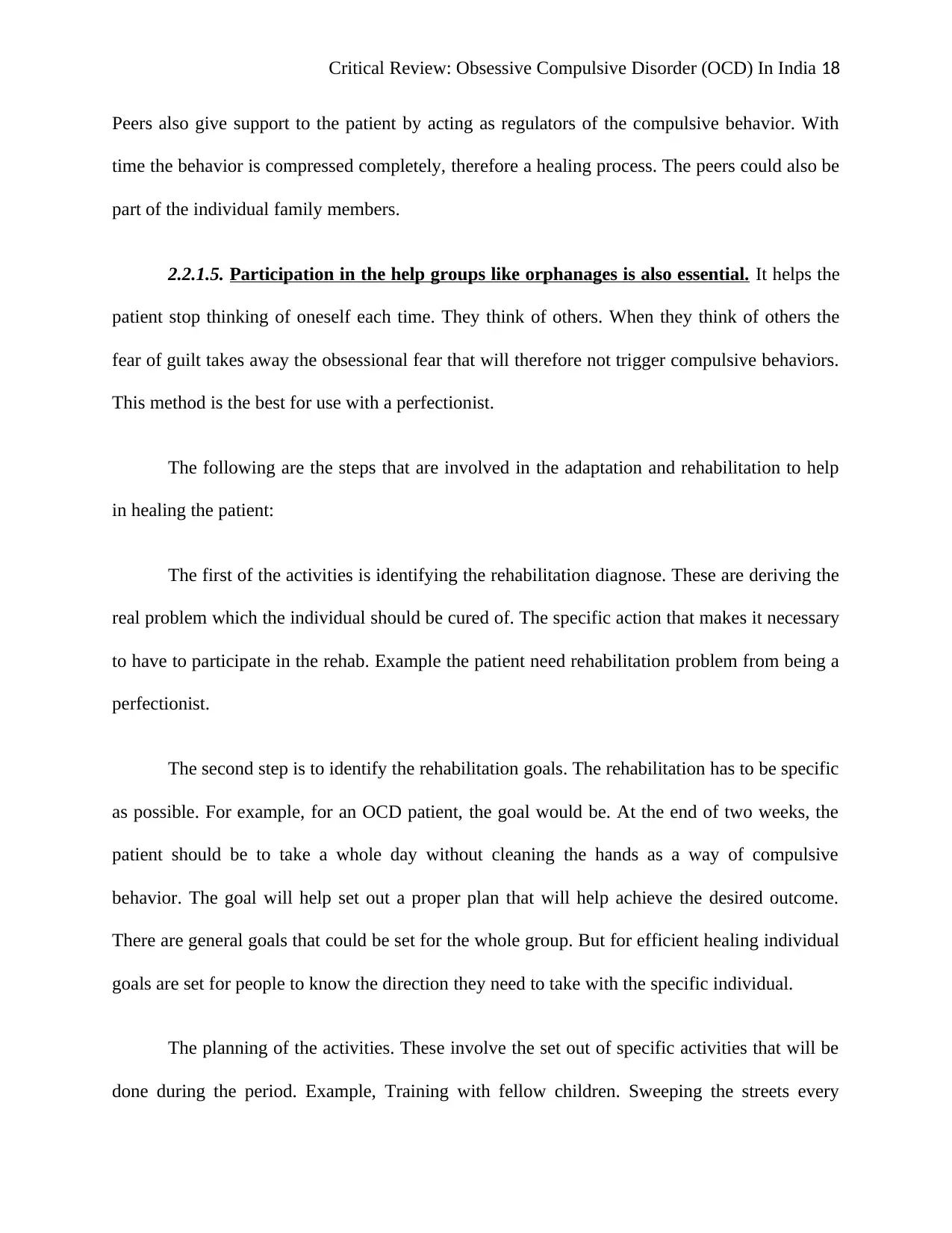
Critical Review: Obsessive Compulsive Disorder (OCD) In India 18
Peers also give support to the patient by acting as regulators of the compulsive behavior. With
time the behavior is compressed completely, therefore a healing process. The peers could also be
part of the individual family members.
2.2.1.5. Participation in the help groups like orphanages is also essential. It helps the
patient stop thinking of oneself each time. They think of others. When they think of others the
fear of guilt takes away the obsessional fear that will therefore not trigger compulsive behaviors.
This method is the best for use with a perfectionist.
The following are the steps that are involved in the adaptation and rehabilitation to help
in healing the patient:
The first of the activities is identifying the rehabilitation diagnose. These are deriving the
real problem which the individual should be cured of. The specific action that makes it necessary
to have to participate in the rehab. Example the patient need rehabilitation problem from being a
perfectionist.
The second step is to identify the rehabilitation goals. The rehabilitation has to be specific
as possible. For example, for an OCD patient, the goal would be. At the end of two weeks, the
patient should be to take a whole day without cleaning the hands as a way of compulsive
behavior. The goal will help set out a proper plan that will help achieve the desired outcome.
There are general goals that could be set for the whole group. But for efficient healing individual
goals are set for people to know the direction they need to take with the specific individual.
The planning of the activities. These involve the set out of specific activities that will be
done during the period. Example, Training with fellow children. Sweeping the streets every
Peers also give support to the patient by acting as regulators of the compulsive behavior. With
time the behavior is compressed completely, therefore a healing process. The peers could also be
part of the individual family members.
2.2.1.5. Participation in the help groups like orphanages is also essential. It helps the
patient stop thinking of oneself each time. They think of others. When they think of others the
fear of guilt takes away the obsessional fear that will therefore not trigger compulsive behaviors.
This method is the best for use with a perfectionist.
The following are the steps that are involved in the adaptation and rehabilitation to help
in healing the patient:
The first of the activities is identifying the rehabilitation diagnose. These are deriving the
real problem which the individual should be cured of. The specific action that makes it necessary
to have to participate in the rehab. Example the patient need rehabilitation problem from being a
perfectionist.
The second step is to identify the rehabilitation goals. The rehabilitation has to be specific
as possible. For example, for an OCD patient, the goal would be. At the end of two weeks, the
patient should be to take a whole day without cleaning the hands as a way of compulsive
behavior. The goal will help set out a proper plan that will help achieve the desired outcome.
There are general goals that could be set for the whole group. But for efficient healing individual
goals are set for people to know the direction they need to take with the specific individual.
The planning of the activities. These involve the set out of specific activities that will be
done during the period. Example, Training with fellow children. Sweeping the streets every

Critical Review: Obsessive Compulsive Disorder (OCD) In India 19
evening. Visiting the children’s home every weekend. These activities should be in line with the
objective that is desired to be achieved. The duration should also involve the duration and the
specific intensity of the activity. Some will take up to 14 weeks and should be conducted daily.
Lastly is the implementation of the program. The rehabilitation program should be
observed by everybody; the trainers, rehabilitation center workers, the family and all the other
members.
Unlike the drugs and therapy which are stopped immediately, there are signs of healing.
Rehabilitation is done until the end of the specified period. All the stages are followed to the
letter and not even one stage is skipped. The rehabilitation can even proceed for several months
or even years. The best method to use for rehabilitating OCD patient is medical-social
rehabilitation. This type of rehabilitation enhances the improvement of the life of the individual.
The individual, therefore, is supposed to heal while improving his social life. The method also
ensures that the healing takes place without the patient struggling so much. Rehabilitation and
adaptation is the only method that doesn’t have side effects when compared to the other healing
methods.
2.3.0. NURSING ROLES FOR OCD PATIENTS
Nurses play a very vital role in the caring of the OCD patients. Considering the stigma
these patients go through nurses take a very vital role in acting as a second god to them. They are
supposed to guide the patients through various roles. The also meet different types of patient.
Some are very difficult while others are easy to deal with. The nurses deal with these patients
without judging them in any of those situations. The following are the important roles that nurses
evening. Visiting the children’s home every weekend. These activities should be in line with the
objective that is desired to be achieved. The duration should also involve the duration and the
specific intensity of the activity. Some will take up to 14 weeks and should be conducted daily.
Lastly is the implementation of the program. The rehabilitation program should be
observed by everybody; the trainers, rehabilitation center workers, the family and all the other
members.
Unlike the drugs and therapy which are stopped immediately, there are signs of healing.
Rehabilitation is done until the end of the specified period. All the stages are followed to the
letter and not even one stage is skipped. The rehabilitation can even proceed for several months
or even years. The best method to use for rehabilitating OCD patient is medical-social
rehabilitation. This type of rehabilitation enhances the improvement of the life of the individual.
The individual, therefore, is supposed to heal while improving his social life. The method also
ensures that the healing takes place without the patient struggling so much. Rehabilitation and
adaptation is the only method that doesn’t have side effects when compared to the other healing
methods.
2.3.0. NURSING ROLES FOR OCD PATIENTS
Nurses play a very vital role in the caring of the OCD patients. Considering the stigma
these patients go through nurses take a very vital role in acting as a second god to them. They are
supposed to guide the patients through various roles. The also meet different types of patient.
Some are very difficult while others are easy to deal with. The nurses deal with these patients
without judging them in any of those situations. The following are the important roles that nurses
Paraphrase This Document
Need a fresh take? Get an instant paraphrase of this document with our AI Paraphraser

Critical Review: Obsessive Compulsive Disorder (OCD) In India 20
play in making sure that OCD patients receive high-quality care. These are most specific to
Indian nurses.
Nurses help the patients identify the anxiety trigger of their obsessional fear. The OCD
patients are triggered by particular anxieties that lead to obsessional fear. These fears will then
reflect compulsive activities. The compulsive activities are normally the end observable features.
The features are seen by everyone are not important for a nurse. The nurse should identify the
trigger and make sure the patient avoids at all costs. The nurse after identifying the trigger
simply stays patient until the patient proceeding into performing the ritual. The role of a nurse is,
therefore, to remain as patient as they can as the patient takes the ritual. It doesn’t matter how
many times the patient does it?
Secondly, it is also the nurse's role to gently ask the patient to speak about his condition.
These involve making the patient state the obsessional fear that goes own overtly. The nurse
should also make the patient concentrate on the conversation and focus less on the compulsive
act. These the nurse does through collaboration with the patient. The nurse can also do this by
encouraging the patients into positive reinforcements. The nurse can also begin limiting the time
given to perform the rituals and give time to the function of the conversation.
The nurse should also not judge the patient. They should not in any way criticize the
behavior of the patient. The nurse should allow the patient know that they have noticed there
anxiety. This can be done through sparkling a conversation with the patient that allows them
expressing their feelings. Example a nurse would say. “I notice you have wiped your hands
thrice, is there anything wrong with them”. These will also help in reducing their anxiety. A
nurse can, therefore, provide another optional activity to lower that patient’s anxiety.
play in making sure that OCD patients receive high-quality care. These are most specific to
Indian nurses.
Nurses help the patients identify the anxiety trigger of their obsessional fear. The OCD
patients are triggered by particular anxieties that lead to obsessional fear. These fears will then
reflect compulsive activities. The compulsive activities are normally the end observable features.
The features are seen by everyone are not important for a nurse. The nurse should identify the
trigger and make sure the patient avoids at all costs. The nurse after identifying the trigger
simply stays patient until the patient proceeding into performing the ritual. The role of a nurse is,
therefore, to remain as patient as they can as the patient takes the ritual. It doesn’t matter how
many times the patient does it?
Secondly, it is also the nurse's role to gently ask the patient to speak about his condition.
These involve making the patient state the obsessional fear that goes own overtly. The nurse
should also make the patient concentrate on the conversation and focus less on the compulsive
act. These the nurse does through collaboration with the patient. The nurse can also do this by
encouraging the patients into positive reinforcements. The nurse can also begin limiting the time
given to perform the rituals and give time to the function of the conversation.
The nurse should also not judge the patient. They should not in any way criticize the
behavior of the patient. The nurse should allow the patient know that they have noticed there
anxiety. This can be done through sparkling a conversation with the patient that allows them
expressing their feelings. Example a nurse would say. “I notice you have wiped your hands
thrice, is there anything wrong with them”. These will also help in reducing their anxiety. A
nurse can, therefore, provide another optional activity to lower that patient’s anxiety.

Critical Review: Obsessive Compulsive Disorder (OCD) In India 21
The nurse should keep the OCD welfare in mind. The patient could perform a ritual that
goes further to cause harm to them. A patient that keeps on scrubbing the hands is likely to injure
the hands (Yoshinaga et al. 2014). The patient could be switching on and off electric lines so
many times until they are about to blow off. The nurse should guide the learner in identifying the
acts that will not cause him harm. The nurse should also be aware of activities that cause
exhaustion to the patient and therefore offer rest and nutrition.
The nurse should make reasonable demands to the patient. Any demands that provoke
anger from the patient should be avoided. The demands too that not only cause anger but anxiety
to the patient should also be avoided.
The nurse should know the patients preferred patterns. This is in relation to patients that
identify with particular arrangements and symmetries. The nurse should, therefore, create a way
of knowing the preferred pattern of the patient (Yan et al. 2016). They can do this by interfering
with the pattern and allowing the patient to arrange them again. The most important patterns are
the ones that lead to a specific compulsive behavior.
Listen to the demands of the patient carefully. These demands help to determine the
obsessional fear.
If the patient is upset, it is good for the nurse to design activities that will breed happiness
to the patient. The nurse should discourage activities that encourage loneliness and isolation of
the patient. The patient is encouraged to the fear when they are lonely.
The nurse should keep the OCD welfare in mind. The patient could perform a ritual that
goes further to cause harm to them. A patient that keeps on scrubbing the hands is likely to injure
the hands (Yoshinaga et al. 2014). The patient could be switching on and off electric lines so
many times until they are about to blow off. The nurse should guide the learner in identifying the
acts that will not cause him harm. The nurse should also be aware of activities that cause
exhaustion to the patient and therefore offer rest and nutrition.
The nurse should make reasonable demands to the patient. Any demands that provoke
anger from the patient should be avoided. The demands too that not only cause anger but anxiety
to the patient should also be avoided.
The nurse should know the patients preferred patterns. This is in relation to patients that
identify with particular arrangements and symmetries. The nurse should, therefore, create a way
of knowing the preferred pattern of the patient (Yan et al. 2016). They can do this by interfering
with the pattern and allowing the patient to arrange them again. The most important patterns are
the ones that lead to a specific compulsive behavior.
Listen to the demands of the patient carefully. These demands help to determine the
obsessional fear.
If the patient is upset, it is good for the nurse to design activities that will breed happiness
to the patient. The nurse should discourage activities that encourage loneliness and isolation of
the patient. The patient is encouraged to the fear when they are lonely.
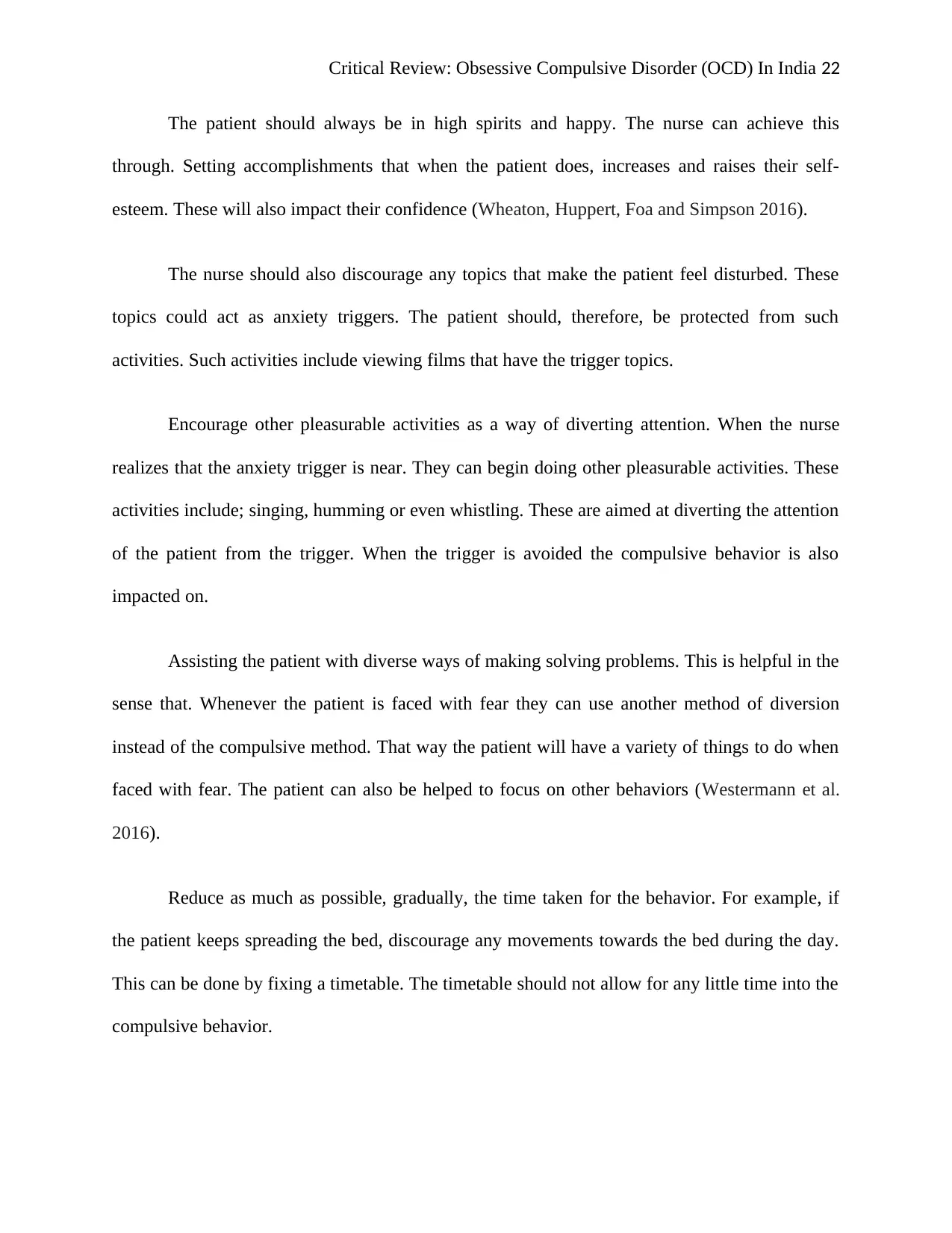
Critical Review: Obsessive Compulsive Disorder (OCD) In India 22
The patient should always be in high spirits and happy. The nurse can achieve this
through. Setting accomplishments that when the patient does, increases and raises their self-
esteem. These will also impact their confidence (Wheaton, Huppert, Foa and Simpson 2016).
The nurse should also discourage any topics that make the patient feel disturbed. These
topics could act as anxiety triggers. The patient should, therefore, be protected from such
activities. Such activities include viewing films that have the trigger topics.
Encourage other pleasurable activities as a way of diverting attention. When the nurse
realizes that the anxiety trigger is near. They can begin doing other pleasurable activities. These
activities include; singing, humming or even whistling. These are aimed at diverting the attention
of the patient from the trigger. When the trigger is avoided the compulsive behavior is also
impacted on.
Assisting the patient with diverse ways of making solving problems. This is helpful in the
sense that. Whenever the patient is faced with fear they can use another method of diversion
instead of the compulsive method. That way the patient will have a variety of things to do when
faced with fear. The patient can also be helped to focus on other behaviors (Westermann et al.
2016).
Reduce as much as possible, gradually, the time taken for the behavior. For example, if
the patient keeps spreading the bed, discourage any movements towards the bed during the day.
This can be done by fixing a timetable. The timetable should not allow for any little time into the
compulsive behavior.
The patient should always be in high spirits and happy. The nurse can achieve this
through. Setting accomplishments that when the patient does, increases and raises their self-
esteem. These will also impact their confidence (Wheaton, Huppert, Foa and Simpson 2016).
The nurse should also discourage any topics that make the patient feel disturbed. These
topics could act as anxiety triggers. The patient should, therefore, be protected from such
activities. Such activities include viewing films that have the trigger topics.
Encourage other pleasurable activities as a way of diverting attention. When the nurse
realizes that the anxiety trigger is near. They can begin doing other pleasurable activities. These
activities include; singing, humming or even whistling. These are aimed at diverting the attention
of the patient from the trigger. When the trigger is avoided the compulsive behavior is also
impacted on.
Assisting the patient with diverse ways of making solving problems. This is helpful in the
sense that. Whenever the patient is faced with fear they can use another method of diversion
instead of the compulsive method. That way the patient will have a variety of things to do when
faced with fear. The patient can also be helped to focus on other behaviors (Westermann et al.
2016).
Reduce as much as possible, gradually, the time taken for the behavior. For example, if
the patient keeps spreading the bed, discourage any movements towards the bed during the day.
This can be done by fixing a timetable. The timetable should not allow for any little time into the
compulsive behavior.
Secure Best Marks with AI Grader
Need help grading? Try our AI Grader for instant feedback on your assignments.
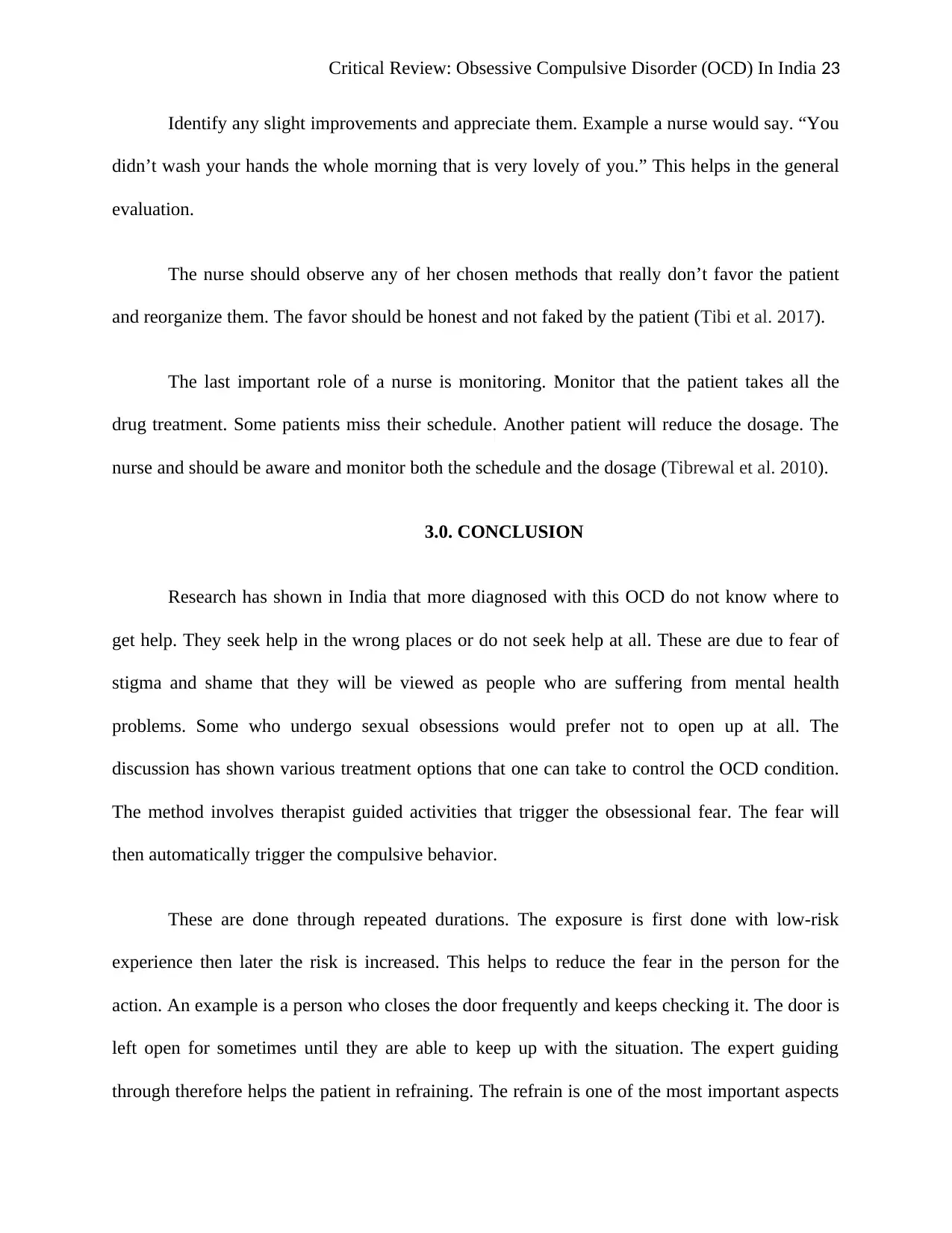
Critical Review: Obsessive Compulsive Disorder (OCD) In India 23
Identify any slight improvements and appreciate them. Example a nurse would say. “You
didn’t wash your hands the whole morning that is very lovely of you.” This helps in the general
evaluation.
The nurse should observe any of her chosen methods that really don’t favor the patient
and reorganize them. The favor should be honest and not faked by the patient (Tibi et al. 2017).
The last important role of a nurse is monitoring. Monitor that the patient takes all the
drug treatment. Some patients miss their schedule. Another patient will reduce the dosage. The
nurse and should be aware and monitor both the schedule and the dosage (Tibrewal et al. 2010).
3.0. CONCLUSION
Research has shown in India that more diagnosed with this OCD do not know where to
get help. They seek help in the wrong places or do not seek help at all. These are due to fear of
stigma and shame that they will be viewed as people who are suffering from mental health
problems. Some who undergo sexual obsessions would prefer not to open up at all. The
discussion has shown various treatment options that one can take to control the OCD condition.
The method involves therapist guided activities that trigger the obsessional fear. The fear will
then automatically trigger the compulsive behavior.
These are done through repeated durations. The exposure is first done with low-risk
experience then later the risk is increased. This helps to reduce the fear in the person for the
action. An example is a person who closes the door frequently and keeps checking it. The door is
left open for sometimes until they are able to keep up with the situation. The expert guiding
through therefore helps the patient in refraining. The refrain is one of the most important aspects
Identify any slight improvements and appreciate them. Example a nurse would say. “You
didn’t wash your hands the whole morning that is very lovely of you.” This helps in the general
evaluation.
The nurse should observe any of her chosen methods that really don’t favor the patient
and reorganize them. The favor should be honest and not faked by the patient (Tibi et al. 2017).
The last important role of a nurse is monitoring. Monitor that the patient takes all the
drug treatment. Some patients miss their schedule. Another patient will reduce the dosage. The
nurse and should be aware and monitor both the schedule and the dosage (Tibrewal et al. 2010).
3.0. CONCLUSION
Research has shown in India that more diagnosed with this OCD do not know where to
get help. They seek help in the wrong places or do not seek help at all. These are due to fear of
stigma and shame that they will be viewed as people who are suffering from mental health
problems. Some who undergo sexual obsessions would prefer not to open up at all. The
discussion has shown various treatment options that one can take to control the OCD condition.
The method involves therapist guided activities that trigger the obsessional fear. The fear will
then automatically trigger the compulsive behavior.
These are done through repeated durations. The exposure is first done with low-risk
experience then later the risk is increased. This helps to reduce the fear in the person for the
action. An example is a person who closes the door frequently and keeps checking it. The door is
left open for sometimes until they are able to keep up with the situation. The expert guiding
through therefore helps the patient in refraining. The refrain is one of the most important aspects
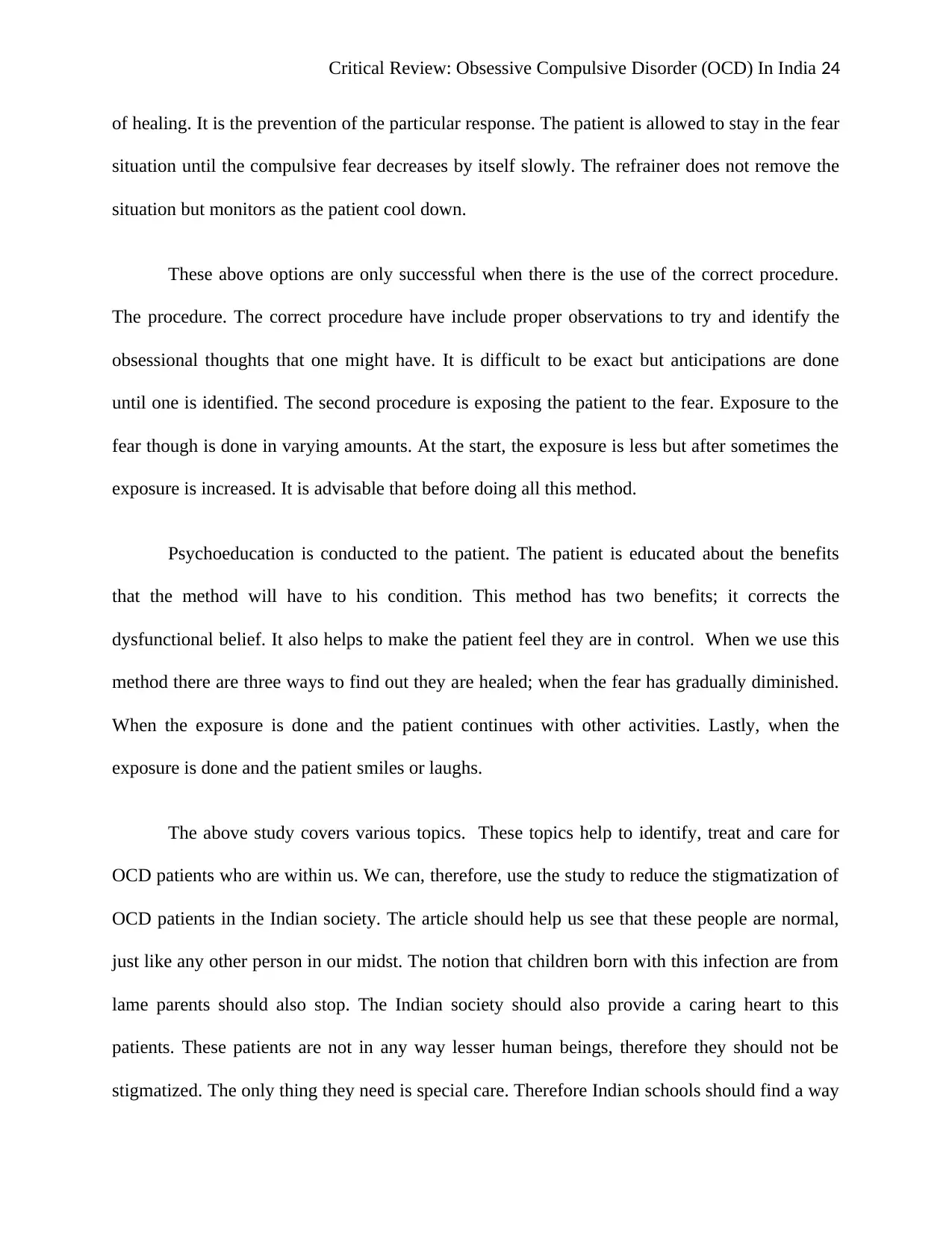
Critical Review: Obsessive Compulsive Disorder (OCD) In India 24
of healing. It is the prevention of the particular response. The patient is allowed to stay in the fear
situation until the compulsive fear decreases by itself slowly. The refrainer does not remove the
situation but monitors as the patient cool down.
These above options are only successful when there is the use of the correct procedure.
The procedure. The correct procedure have include proper observations to try and identify the
obsessional thoughts that one might have. It is difficult to be exact but anticipations are done
until one is identified. The second procedure is exposing the patient to the fear. Exposure to the
fear though is done in varying amounts. At the start, the exposure is less but after sometimes the
exposure is increased. It is advisable that before doing all this method.
Psychoeducation is conducted to the patient. The patient is educated about the benefits
that the method will have to his condition. This method has two benefits; it corrects the
dysfunctional belief. It also helps to make the patient feel they are in control. When we use this
method there are three ways to find out they are healed; when the fear has gradually diminished.
When the exposure is done and the patient continues with other activities. Lastly, when the
exposure is done and the patient smiles or laughs.
The above study covers various topics. These topics help to identify, treat and care for
OCD patients who are within us. We can, therefore, use the study to reduce the stigmatization of
OCD patients in the Indian society. The article should help us see that these people are normal,
just like any other person in our midst. The notion that children born with this infection are from
lame parents should also stop. The Indian society should also provide a caring heart to this
patients. These patients are not in any way lesser human beings, therefore they should not be
stigmatized. The only thing they need is special care. Therefore Indian schools should find a way
of healing. It is the prevention of the particular response. The patient is allowed to stay in the fear
situation until the compulsive fear decreases by itself slowly. The refrainer does not remove the
situation but monitors as the patient cool down.
These above options are only successful when there is the use of the correct procedure.
The procedure. The correct procedure have include proper observations to try and identify the
obsessional thoughts that one might have. It is difficult to be exact but anticipations are done
until one is identified. The second procedure is exposing the patient to the fear. Exposure to the
fear though is done in varying amounts. At the start, the exposure is less but after sometimes the
exposure is increased. It is advisable that before doing all this method.
Psychoeducation is conducted to the patient. The patient is educated about the benefits
that the method will have to his condition. This method has two benefits; it corrects the
dysfunctional belief. It also helps to make the patient feel they are in control. When we use this
method there are three ways to find out they are healed; when the fear has gradually diminished.
When the exposure is done and the patient continues with other activities. Lastly, when the
exposure is done and the patient smiles or laughs.
The above study covers various topics. These topics help to identify, treat and care for
OCD patients who are within us. We can, therefore, use the study to reduce the stigmatization of
OCD patients in the Indian society. The article should help us see that these people are normal,
just like any other person in our midst. The notion that children born with this infection are from
lame parents should also stop. The Indian society should also provide a caring heart to this
patients. These patients are not in any way lesser human beings, therefore they should not be
stigmatized. The only thing they need is special care. Therefore Indian schools should find a way

Critical Review: Obsessive Compulsive Disorder (OCD) In India 25
of endorsing them into the system. The Indian government should also give attention to the
disease. This is after the WHO identifies it as one of the most handicap diseases in the world.
of endorsing them into the system. The Indian government should also give attention to the
disease. This is after the WHO identifies it as one of the most handicap diseases in the world.
Paraphrase This Document
Need a fresh take? Get an instant paraphrase of this document with our AI Paraphraser

Critical Review: Obsessive Compulsive Disorder (OCD) In India 26
4.0 REFERENCES
Andersson, E., Hedman, E., Enander, J., Djurfeldt, D.R., Ljótsson, B., Cervenka, S., Isung, J.,
Svanborg, C., Mataix-Cols, D., Kaldo, V. and Andersson, G., 2015. D-cycloserine vs placebo as
adjunct to cognitive behavioral therapy for obsessive-compulsive disorder and interaction with
antidepressants: a randomized clinical trial. JAMA psychiatry, 72(7), pp.659-667.
Angelakis, I., Gooding, P., Tarrier, N. and Panagioti, M., 2015. Suicidality in obsessive
compulsive disorder (OCD): a systematic review and meta-analysis. Clinical psychology
review, 39, pp.1-15.
Aspvall, K., Andrén, P., Lenhard, F., Andersson, E., Mataix-Cols, D. and Serlachius, E., 2018.
Internet-delivered cognitive behavioural therapy for young children with obsessive–compulsive
disorder: development and initial evaluation of the BIP OCD Junior programme. BJPsych
Open, 4(3), pp.106-112.
Boedhoe, P.S., Schmaal, L., Abe, Y., Alonso, P., Ameis, S.H., Anticevic, A., Arnold, P.D.,
Batistuzzo, M.C., Benedetti, F., Beucke, J.C. and Bollettini, I., 2017. Cortical Abnormalities
Associated With Pediatric and Adult Obsessive-Compulsive Disorder: Findings From the
ENIGMA Obsessive-Compulsive Disorder Working Group. American Journal of Psychiatry,
pp.appi-ajp.
Brakoulias, V., Starcevic, V., Belloch, A., Brown, C., Ferrao, Y.A., Fontenelle, L.F., Lochner,
C., Marazziti, D., Matsunaga, H., Miguel, E.C. and Reddy, Y.C.J., 2017. Comorbidity, age of
onset and suicidality in obsessive–compulsive disorder (OCD): An international
collaboration. Comprehensive psychiatry, 76, pp.79-86.
4.0 REFERENCES
Andersson, E., Hedman, E., Enander, J., Djurfeldt, D.R., Ljótsson, B., Cervenka, S., Isung, J.,
Svanborg, C., Mataix-Cols, D., Kaldo, V. and Andersson, G., 2015. D-cycloserine vs placebo as
adjunct to cognitive behavioral therapy for obsessive-compulsive disorder and interaction with
antidepressants: a randomized clinical trial. JAMA psychiatry, 72(7), pp.659-667.
Angelakis, I., Gooding, P., Tarrier, N. and Panagioti, M., 2015. Suicidality in obsessive
compulsive disorder (OCD): a systematic review and meta-analysis. Clinical psychology
review, 39, pp.1-15.
Aspvall, K., Andrén, P., Lenhard, F., Andersson, E., Mataix-Cols, D. and Serlachius, E., 2018.
Internet-delivered cognitive behavioural therapy for young children with obsessive–compulsive
disorder: development and initial evaluation of the BIP OCD Junior programme. BJPsych
Open, 4(3), pp.106-112.
Boedhoe, P.S., Schmaal, L., Abe, Y., Alonso, P., Ameis, S.H., Anticevic, A., Arnold, P.D.,
Batistuzzo, M.C., Benedetti, F., Beucke, J.C. and Bollettini, I., 2017. Cortical Abnormalities
Associated With Pediatric and Adult Obsessive-Compulsive Disorder: Findings From the
ENIGMA Obsessive-Compulsive Disorder Working Group. American Journal of Psychiatry,
pp.appi-ajp.
Brakoulias, V., Starcevic, V., Belloch, A., Brown, C., Ferrao, Y.A., Fontenelle, L.F., Lochner,
C., Marazziti, D., Matsunaga, H., Miguel, E.C. and Reddy, Y.C.J., 2017. Comorbidity, age of
onset and suicidality in obsessive–compulsive disorder (OCD): An international
collaboration. Comprehensive psychiatry, 76, pp.79-86.
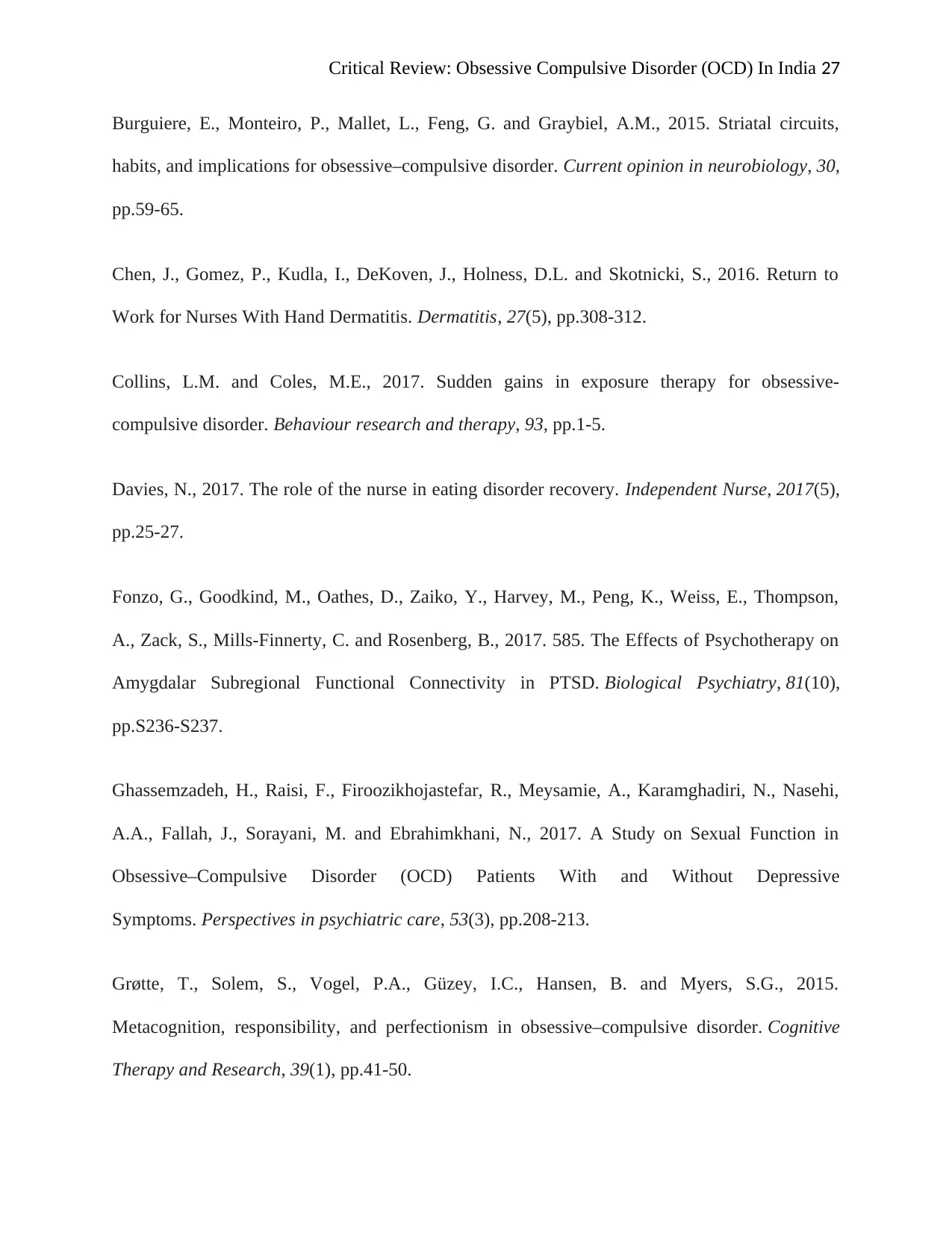
Critical Review: Obsessive Compulsive Disorder (OCD) In India 27
Burguiere, E., Monteiro, P., Mallet, L., Feng, G. and Graybiel, A.M., 2015. Striatal circuits,
habits, and implications for obsessive–compulsive disorder. Current opinion in neurobiology, 30,
pp.59-65.
Chen, J., Gomez, P., Kudla, I., DeKoven, J., Holness, D.L. and Skotnicki, S., 2016. Return to
Work for Nurses With Hand Dermatitis. Dermatitis, 27(5), pp.308-312.
Collins, L.M. and Coles, M.E., 2017. Sudden gains in exposure therapy for obsessive-
compulsive disorder. Behaviour research and therapy, 93, pp.1-5.
Davies, N., 2017. The role of the nurse in eating disorder recovery. Independent Nurse, 2017(5),
pp.25-27.
Fonzo, G., Goodkind, M., Oathes, D., Zaiko, Y., Harvey, M., Peng, K., Weiss, E., Thompson,
A., Zack, S., Mills-Finnerty, C. and Rosenberg, B., 2017. 585. The Effects of Psychotherapy on
Amygdalar Subregional Functional Connectivity in PTSD. Biological Psychiatry, 81(10),
pp.S236-S237.
Ghassemzadeh, H., Raisi, F., Firoozikhojastefar, R., Meysamie, A., Karamghadiri, N., Nasehi,
A.A., Fallah, J., Sorayani, M. and Ebrahimkhani, N., 2017. A Study on Sexual Function in
Obsessive–Compulsive Disorder (OCD) Patients With and Without Depressive
Symptoms. Perspectives in psychiatric care, 53(3), pp.208-213.
Grøtte, T., Solem, S., Vogel, P.A., Güzey, I.C., Hansen, B. and Myers, S.G., 2015.
Metacognition, responsibility, and perfectionism in obsessive–compulsive disorder. Cognitive
Therapy and Research, 39(1), pp.41-50.
Burguiere, E., Monteiro, P., Mallet, L., Feng, G. and Graybiel, A.M., 2015. Striatal circuits,
habits, and implications for obsessive–compulsive disorder. Current opinion in neurobiology, 30,
pp.59-65.
Chen, J., Gomez, P., Kudla, I., DeKoven, J., Holness, D.L. and Skotnicki, S., 2016. Return to
Work for Nurses With Hand Dermatitis. Dermatitis, 27(5), pp.308-312.
Collins, L.M. and Coles, M.E., 2017. Sudden gains in exposure therapy for obsessive-
compulsive disorder. Behaviour research and therapy, 93, pp.1-5.
Davies, N., 2017. The role of the nurse in eating disorder recovery. Independent Nurse, 2017(5),
pp.25-27.
Fonzo, G., Goodkind, M., Oathes, D., Zaiko, Y., Harvey, M., Peng, K., Weiss, E., Thompson,
A., Zack, S., Mills-Finnerty, C. and Rosenberg, B., 2017. 585. The Effects of Psychotherapy on
Amygdalar Subregional Functional Connectivity in PTSD. Biological Psychiatry, 81(10),
pp.S236-S237.
Ghassemzadeh, H., Raisi, F., Firoozikhojastefar, R., Meysamie, A., Karamghadiri, N., Nasehi,
A.A., Fallah, J., Sorayani, M. and Ebrahimkhani, N., 2017. A Study on Sexual Function in
Obsessive–Compulsive Disorder (OCD) Patients With and Without Depressive
Symptoms. Perspectives in psychiatric care, 53(3), pp.208-213.
Grøtte, T., Solem, S., Vogel, P.A., Güzey, I.C., Hansen, B. and Myers, S.G., 2015.
Metacognition, responsibility, and perfectionism in obsessive–compulsive disorder. Cognitive
Therapy and Research, 39(1), pp.41-50.
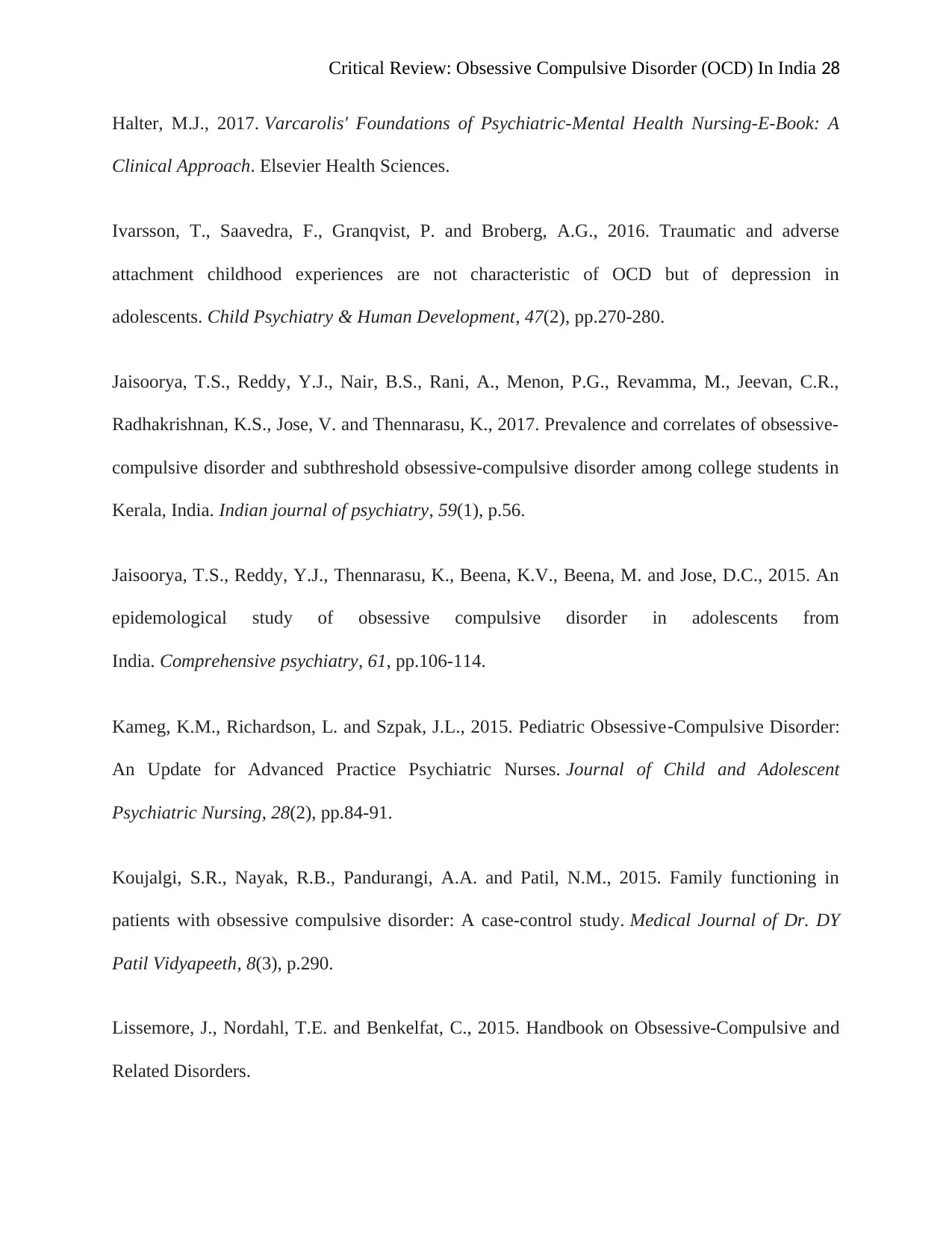
Critical Review: Obsessive Compulsive Disorder (OCD) In India 28
Halter, M.J., 2017. Varcarolis' Foundations of Psychiatric-Mental Health Nursing-E-Book: A
Clinical Approach. Elsevier Health Sciences.
Ivarsson, T., Saavedra, F., Granqvist, P. and Broberg, A.G., 2016. Traumatic and adverse
attachment childhood experiences are not characteristic of OCD but of depression in
adolescents. Child Psychiatry & Human Development, 47(2), pp.270-280.
Jaisoorya, T.S., Reddy, Y.J., Nair, B.S., Rani, A., Menon, P.G., Revamma, M., Jeevan, C.R.,
Radhakrishnan, K.S., Jose, V. and Thennarasu, K., 2017. Prevalence and correlates of obsessive-
compulsive disorder and subthreshold obsessive-compulsive disorder among college students in
Kerala, India. Indian journal of psychiatry, 59(1), p.56.
Jaisoorya, T.S., Reddy, Y.J., Thennarasu, K., Beena, K.V., Beena, M. and Jose, D.C., 2015. An
epidemological study of obsessive compulsive disorder in adolescents from
India. Comprehensive psychiatry, 61, pp.106-114.
Kameg, K.M., Richardson, L. and Szpak, J.L., 2015. Pediatric Obsessive‐Compulsive Disorder:
An Update for Advanced Practice Psychiatric Nurses. Journal of Child and Adolescent
Psychiatric Nursing, 28(2), pp.84-91.
Koujalgi, S.R., Nayak, R.B., Pandurangi, A.A. and Patil, N.M., 2015. Family functioning in
patients with obsessive compulsive disorder: A case-control study. Medical Journal of Dr. DY
Patil Vidyapeeth, 8(3), p.290.
Lissemore, J., Nordahl, T.E. and Benkelfat, C., 2015. Handbook on Obsessive-Compulsive and
Related Disorders.
Halter, M.J., 2017. Varcarolis' Foundations of Psychiatric-Mental Health Nursing-E-Book: A
Clinical Approach. Elsevier Health Sciences.
Ivarsson, T., Saavedra, F., Granqvist, P. and Broberg, A.G., 2016. Traumatic and adverse
attachment childhood experiences are not characteristic of OCD but of depression in
adolescents. Child Psychiatry & Human Development, 47(2), pp.270-280.
Jaisoorya, T.S., Reddy, Y.J., Nair, B.S., Rani, A., Menon, P.G., Revamma, M., Jeevan, C.R.,
Radhakrishnan, K.S., Jose, V. and Thennarasu, K., 2017. Prevalence and correlates of obsessive-
compulsive disorder and subthreshold obsessive-compulsive disorder among college students in
Kerala, India. Indian journal of psychiatry, 59(1), p.56.
Jaisoorya, T.S., Reddy, Y.J., Thennarasu, K., Beena, K.V., Beena, M. and Jose, D.C., 2015. An
epidemological study of obsessive compulsive disorder in adolescents from
India. Comprehensive psychiatry, 61, pp.106-114.
Kameg, K.M., Richardson, L. and Szpak, J.L., 2015. Pediatric Obsessive‐Compulsive Disorder:
An Update for Advanced Practice Psychiatric Nurses. Journal of Child and Adolescent
Psychiatric Nursing, 28(2), pp.84-91.
Koujalgi, S.R., Nayak, R.B., Pandurangi, A.A. and Patil, N.M., 2015. Family functioning in
patients with obsessive compulsive disorder: A case-control study. Medical Journal of Dr. DY
Patil Vidyapeeth, 8(3), p.290.
Lissemore, J., Nordahl, T.E. and Benkelfat, C., 2015. Handbook on Obsessive-Compulsive and
Related Disorders.
Secure Best Marks with AI Grader
Need help grading? Try our AI Grader for instant feedback on your assignments.
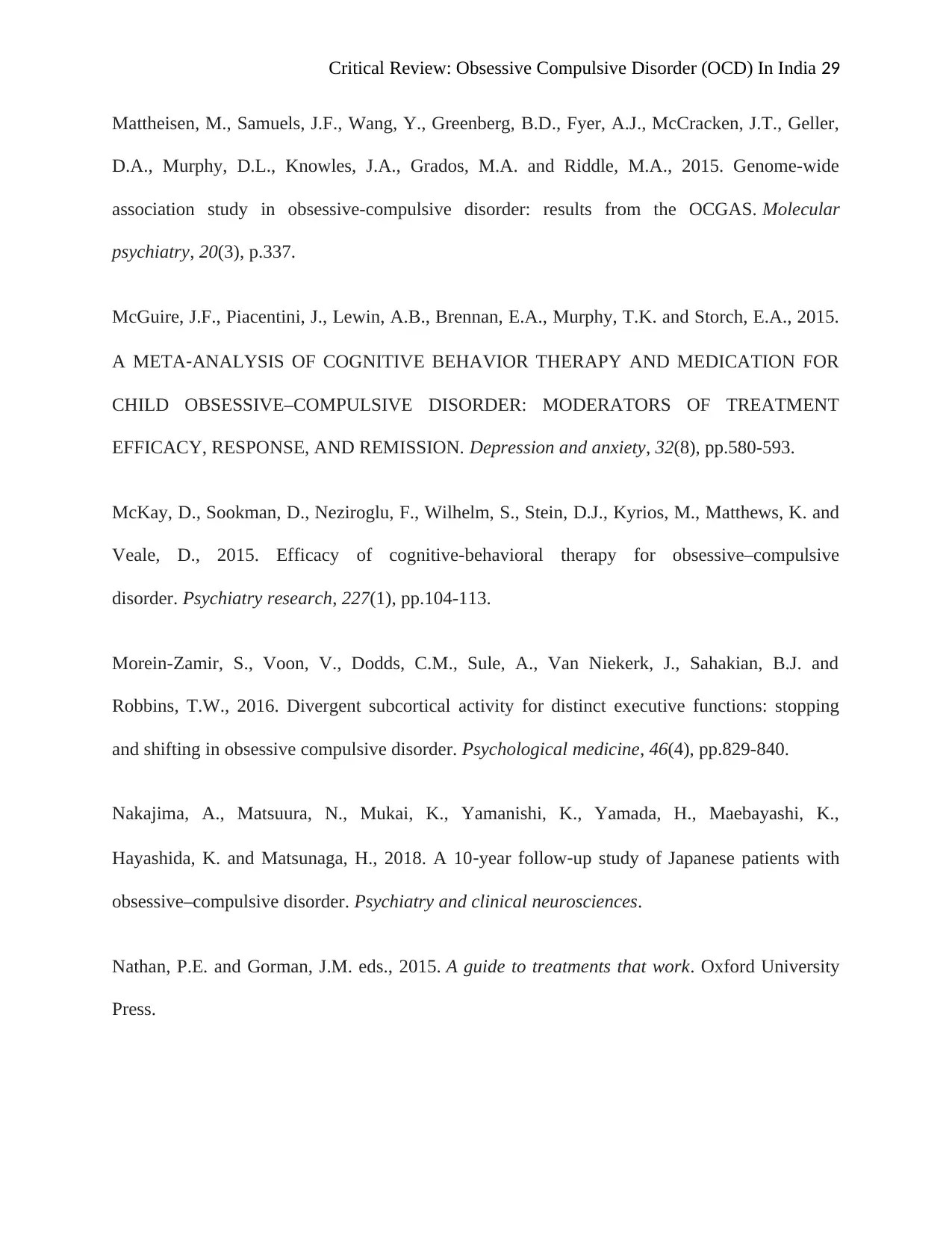
Critical Review: Obsessive Compulsive Disorder (OCD) In India 29
Mattheisen, M., Samuels, J.F., Wang, Y., Greenberg, B.D., Fyer, A.J., McCracken, J.T., Geller,
D.A., Murphy, D.L., Knowles, J.A., Grados, M.A. and Riddle, M.A., 2015. Genome-wide
association study in obsessive-compulsive disorder: results from the OCGAS. Molecular
psychiatry, 20(3), p.337.
McGuire, J.F., Piacentini, J., Lewin, A.B., Brennan, E.A., Murphy, T.K. and Storch, E.A., 2015.
A META‐ANALYSIS OF COGNITIVE BEHAVIOR THERAPY AND MEDICATION FOR
CHILD OBSESSIVE–COMPULSIVE DISORDER: MODERATORS OF TREATMENT
EFFICACY, RESPONSE, AND REMISSION. Depression and anxiety, 32(8), pp.580-593.
McKay, D., Sookman, D., Neziroglu, F., Wilhelm, S., Stein, D.J., Kyrios, M., Matthews, K. and
Veale, D., 2015. Efficacy of cognitive-behavioral therapy for obsessive–compulsive
disorder. Psychiatry research, 227(1), pp.104-113.
Morein-Zamir, S., Voon, V., Dodds, C.M., Sule, A., Van Niekerk, J., Sahakian, B.J. and
Robbins, T.W., 2016. Divergent subcortical activity for distinct executive functions: stopping
and shifting in obsessive compulsive disorder. Psychological medicine, 46(4), pp.829-840.
Nakajima, A., Matsuura, N., Mukai, K., Yamanishi, K., Yamada, H., Maebayashi, K.,
Hayashida, K. and Matsunaga, H., 2018. A 10‐year follow‐up study of Japanese patients with
obsessive–compulsive disorder. Psychiatry and clinical neurosciences.
Nathan, P.E. and Gorman, J.M. eds., 2015. A guide to treatments that work. Oxford University
Press.
Mattheisen, M., Samuels, J.F., Wang, Y., Greenberg, B.D., Fyer, A.J., McCracken, J.T., Geller,
D.A., Murphy, D.L., Knowles, J.A., Grados, M.A. and Riddle, M.A., 2015. Genome-wide
association study in obsessive-compulsive disorder: results from the OCGAS. Molecular
psychiatry, 20(3), p.337.
McGuire, J.F., Piacentini, J., Lewin, A.B., Brennan, E.A., Murphy, T.K. and Storch, E.A., 2015.
A META‐ANALYSIS OF COGNITIVE BEHAVIOR THERAPY AND MEDICATION FOR
CHILD OBSESSIVE–COMPULSIVE DISORDER: MODERATORS OF TREATMENT
EFFICACY, RESPONSE, AND REMISSION. Depression and anxiety, 32(8), pp.580-593.
McKay, D., Sookman, D., Neziroglu, F., Wilhelm, S., Stein, D.J., Kyrios, M., Matthews, K. and
Veale, D., 2015. Efficacy of cognitive-behavioral therapy for obsessive–compulsive
disorder. Psychiatry research, 227(1), pp.104-113.
Morein-Zamir, S., Voon, V., Dodds, C.M., Sule, A., Van Niekerk, J., Sahakian, B.J. and
Robbins, T.W., 2016. Divergent subcortical activity for distinct executive functions: stopping
and shifting in obsessive compulsive disorder. Psychological medicine, 46(4), pp.829-840.
Nakajima, A., Matsuura, N., Mukai, K., Yamanishi, K., Yamada, H., Maebayashi, K.,
Hayashida, K. and Matsunaga, H., 2018. A 10‐year follow‐up study of Japanese patients with
obsessive–compulsive disorder. Psychiatry and clinical neurosciences.
Nathan, P.E. and Gorman, J.M. eds., 2015. A guide to treatments that work. Oxford University
Press.
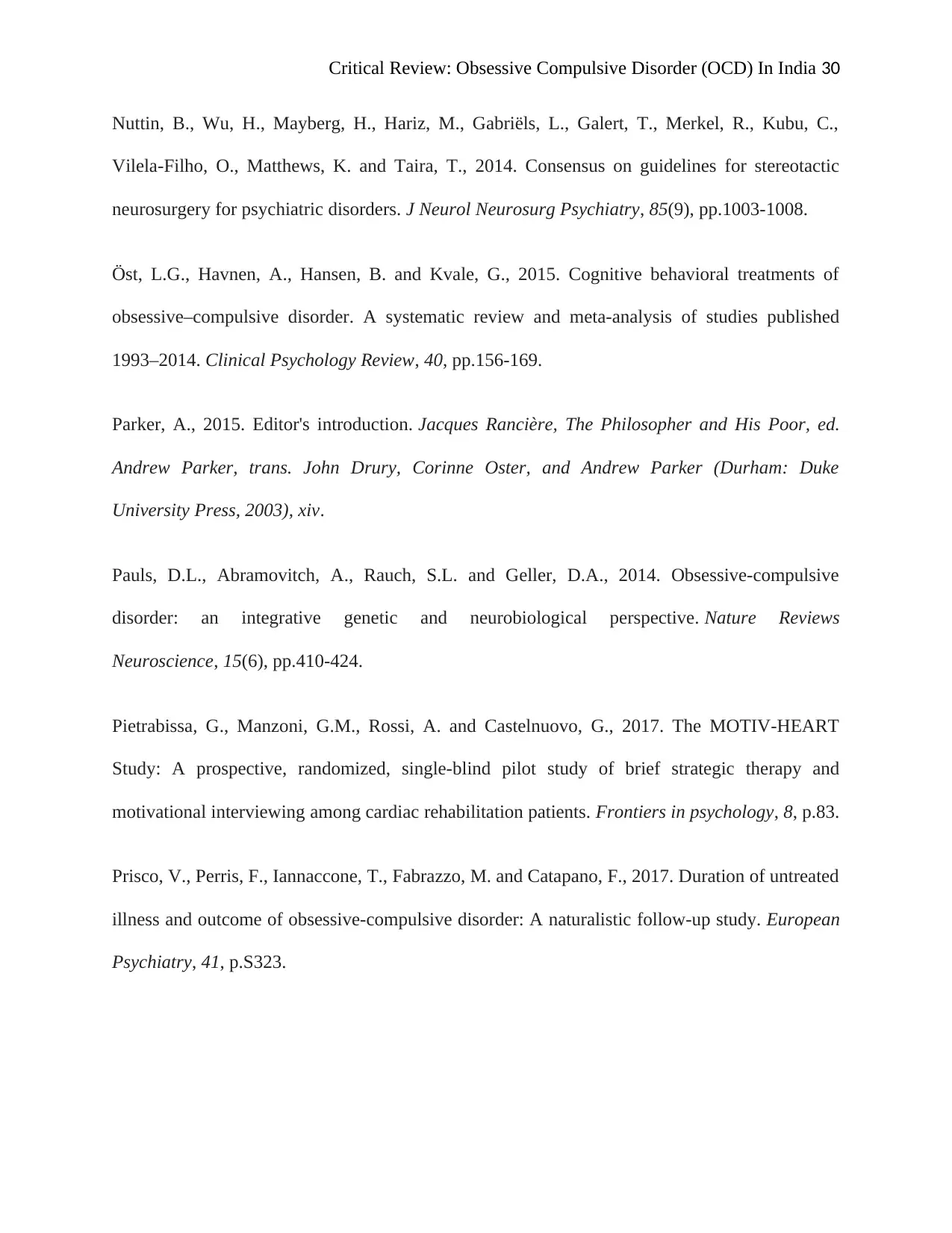
Critical Review: Obsessive Compulsive Disorder (OCD) In India 30
Nuttin, B., Wu, H., Mayberg, H., Hariz, M., Gabriëls, L., Galert, T., Merkel, R., Kubu, C.,
Vilela-Filho, O., Matthews, K. and Taira, T., 2014. Consensus on guidelines for stereotactic
neurosurgery for psychiatric disorders. J Neurol Neurosurg Psychiatry, 85(9), pp.1003-1008.
Öst, L.G., Havnen, A., Hansen, B. and Kvale, G., 2015. Cognitive behavioral treatments of
obsessive–compulsive disorder. A systematic review and meta-analysis of studies published
1993–2014. Clinical Psychology Review, 40, pp.156-169.
Parker, A., 2015. Editor's introduction. Jacques Rancière, The Philosopher and His Poor, ed.
Andrew Parker, trans. John Drury, Corinne Oster, and Andrew Parker (Durham: Duke
University Press, 2003), xiv.
Pauls, D.L., Abramovitch, A., Rauch, S.L. and Geller, D.A., 2014. Obsessive-compulsive
disorder: an integrative genetic and neurobiological perspective. Nature Reviews
Neuroscience, 15(6), pp.410-424.
Pietrabissa, G., Manzoni, G.M., Rossi, A. and Castelnuovo, G., 2017. The MOTIV-HEART
Study: A prospective, randomized, single-blind pilot study of brief strategic therapy and
motivational interviewing among cardiac rehabilitation patients. Frontiers in psychology, 8, p.83.
Prisco, V., Perris, F., Iannaccone, T., Fabrazzo, M. and Catapano, F., 2017. Duration of untreated
illness and outcome of obsessive-compulsive disorder: A naturalistic follow-up study. European
Psychiatry, 41, p.S323.
Nuttin, B., Wu, H., Mayberg, H., Hariz, M., Gabriëls, L., Galert, T., Merkel, R., Kubu, C.,
Vilela-Filho, O., Matthews, K. and Taira, T., 2014. Consensus on guidelines for stereotactic
neurosurgery for psychiatric disorders. J Neurol Neurosurg Psychiatry, 85(9), pp.1003-1008.
Öst, L.G., Havnen, A., Hansen, B. and Kvale, G., 2015. Cognitive behavioral treatments of
obsessive–compulsive disorder. A systematic review and meta-analysis of studies published
1993–2014. Clinical Psychology Review, 40, pp.156-169.
Parker, A., 2015. Editor's introduction. Jacques Rancière, The Philosopher and His Poor, ed.
Andrew Parker, trans. John Drury, Corinne Oster, and Andrew Parker (Durham: Duke
University Press, 2003), xiv.
Pauls, D.L., Abramovitch, A., Rauch, S.L. and Geller, D.A., 2014. Obsessive-compulsive
disorder: an integrative genetic and neurobiological perspective. Nature Reviews
Neuroscience, 15(6), pp.410-424.
Pietrabissa, G., Manzoni, G.M., Rossi, A. and Castelnuovo, G., 2017. The MOTIV-HEART
Study: A prospective, randomized, single-blind pilot study of brief strategic therapy and
motivational interviewing among cardiac rehabilitation patients. Frontiers in psychology, 8, p.83.
Prisco, V., Perris, F., Iannaccone, T., Fabrazzo, M. and Catapano, F., 2017. Duration of untreated
illness and outcome of obsessive-compulsive disorder: A naturalistic follow-up study. European
Psychiatry, 41, p.S323.
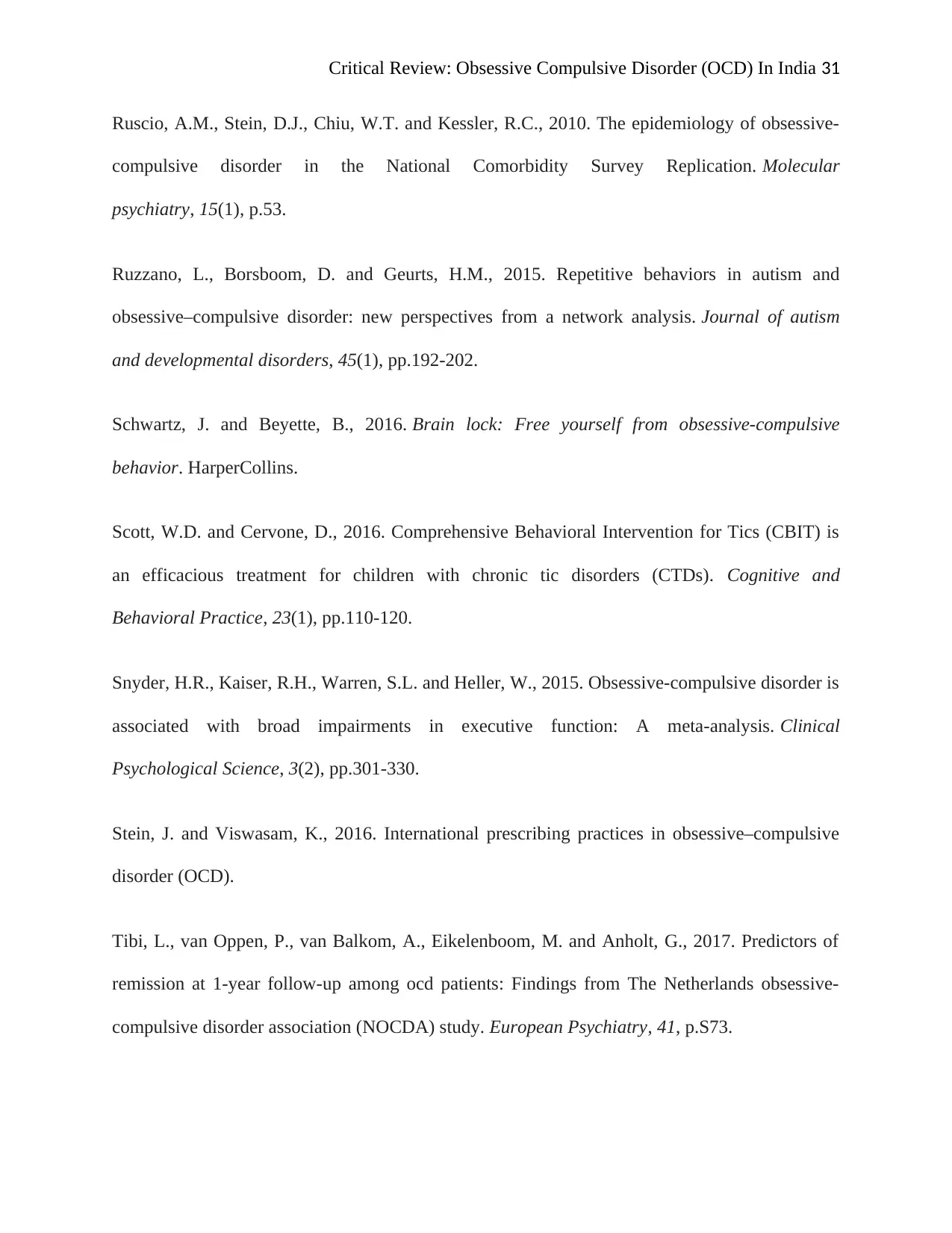
Critical Review: Obsessive Compulsive Disorder (OCD) In India 31
Ruscio, A.M., Stein, D.J., Chiu, W.T. and Kessler, R.C., 2010. The epidemiology of obsessive-
compulsive disorder in the National Comorbidity Survey Replication. Molecular
psychiatry, 15(1), p.53.
Ruzzano, L., Borsboom, D. and Geurts, H.M., 2015. Repetitive behaviors in autism and
obsessive–compulsive disorder: new perspectives from a network analysis. Journal of autism
and developmental disorders, 45(1), pp.192-202.
Schwartz, J. and Beyette, B., 2016. Brain lock: Free yourself from obsessive-compulsive
behavior. HarperCollins.
Scott, W.D. and Cervone, D., 2016. Comprehensive Behavioral Intervention for Tics (CBIT) is
an efficacious treatment for children with chronic tic disorders (CTDs). Cognitive and
Behavioral Practice, 23(1), pp.110-120.
Snyder, H.R., Kaiser, R.H., Warren, S.L. and Heller, W., 2015. Obsessive-compulsive disorder is
associated with broad impairments in executive function: A meta-analysis. Clinical
Psychological Science, 3(2), pp.301-330.
Stein, J. and Viswasam, K., 2016. International prescribing practices in obsessive–compulsive
disorder (OCD).
Tibi, L., van Oppen, P., van Balkom, A., Eikelenboom, M. and Anholt, G., 2017. Predictors of
remission at 1-year follow-up among ocd patients: Findings from The Netherlands obsessive-
compulsive disorder association (NOCDA) study. European Psychiatry, 41, p.S73.
Ruscio, A.M., Stein, D.J., Chiu, W.T. and Kessler, R.C., 2010. The epidemiology of obsessive-
compulsive disorder in the National Comorbidity Survey Replication. Molecular
psychiatry, 15(1), p.53.
Ruzzano, L., Borsboom, D. and Geurts, H.M., 2015. Repetitive behaviors in autism and
obsessive–compulsive disorder: new perspectives from a network analysis. Journal of autism
and developmental disorders, 45(1), pp.192-202.
Schwartz, J. and Beyette, B., 2016. Brain lock: Free yourself from obsessive-compulsive
behavior. HarperCollins.
Scott, W.D. and Cervone, D., 2016. Comprehensive Behavioral Intervention for Tics (CBIT) is
an efficacious treatment for children with chronic tic disorders (CTDs). Cognitive and
Behavioral Practice, 23(1), pp.110-120.
Snyder, H.R., Kaiser, R.H., Warren, S.L. and Heller, W., 2015. Obsessive-compulsive disorder is
associated with broad impairments in executive function: A meta-analysis. Clinical
Psychological Science, 3(2), pp.301-330.
Stein, J. and Viswasam, K., 2016. International prescribing practices in obsessive–compulsive
disorder (OCD).
Tibi, L., van Oppen, P., van Balkom, A., Eikelenboom, M. and Anholt, G., 2017. Predictors of
remission at 1-year follow-up among ocd patients: Findings from The Netherlands obsessive-
compulsive disorder association (NOCDA) study. European Psychiatry, 41, p.S73.
Paraphrase This Document
Need a fresh take? Get an instant paraphrase of this document with our AI Paraphraser
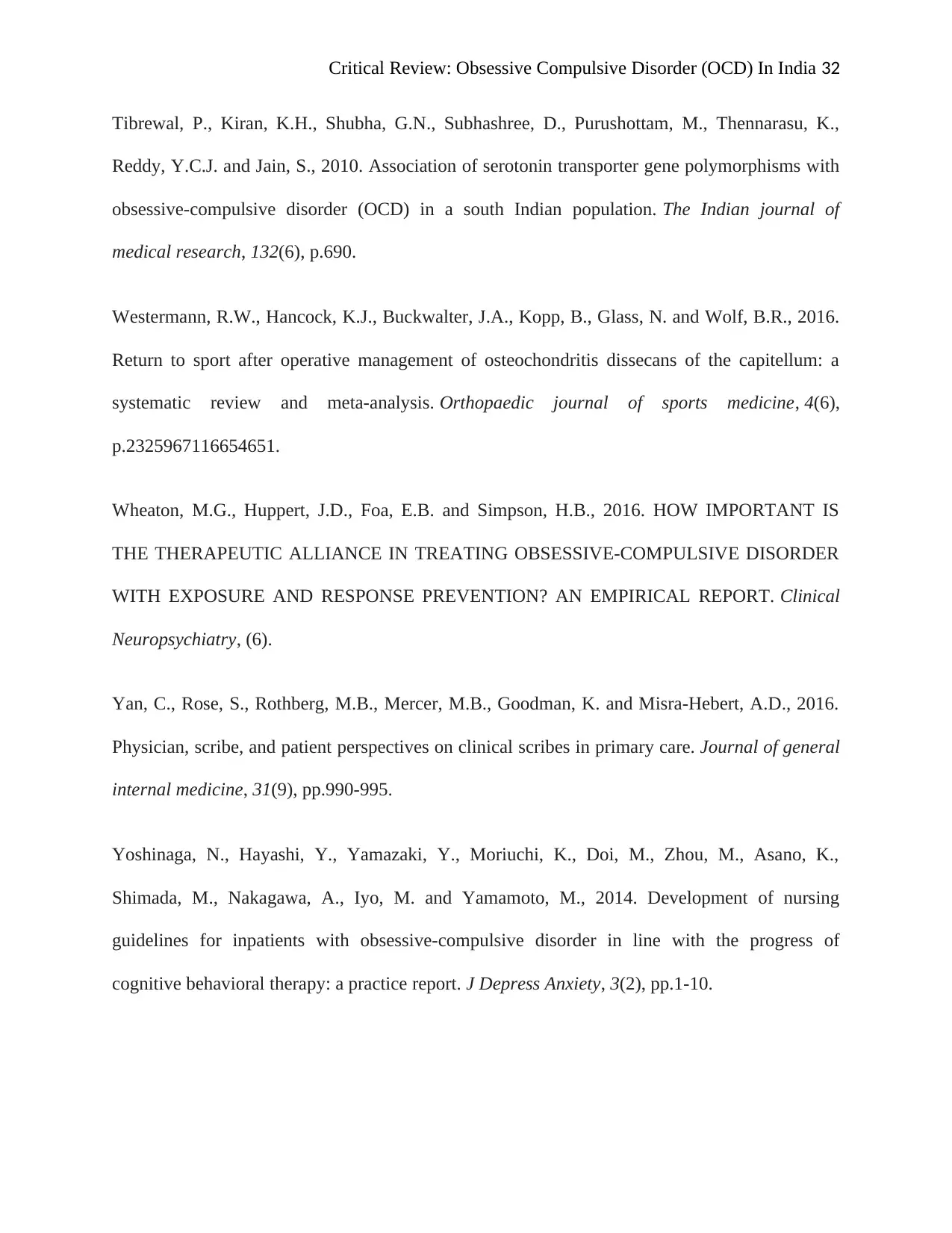
Critical Review: Obsessive Compulsive Disorder (OCD) In India 32
Tibrewal, P., Kiran, K.H., Shubha, G.N., Subhashree, D., Purushottam, M., Thennarasu, K.,
Reddy, Y.C.J. and Jain, S., 2010. Association of serotonin transporter gene polymorphisms with
obsessive-compulsive disorder (OCD) in a south Indian population. The Indian journal of
medical research, 132(6), p.690.
Westermann, R.W., Hancock, K.J., Buckwalter, J.A., Kopp, B., Glass, N. and Wolf, B.R., 2016.
Return to sport after operative management of osteochondritis dissecans of the capitellum: a
systematic review and meta-analysis. Orthopaedic journal of sports medicine, 4(6),
p.2325967116654651.
Wheaton, M.G., Huppert, J.D., Foa, E.B. and Simpson, H.B., 2016. HOW IMPORTANT IS
THE THERAPEUTIC ALLIANCE IN TREATING OBSESSIVE-COMPULSIVE DISORDER
WITH EXPOSURE AND RESPONSE PREVENTION? AN EMPIRICAL REPORT. Clinical
Neuropsychiatry, (6).
Yan, C., Rose, S., Rothberg, M.B., Mercer, M.B., Goodman, K. and Misra-Hebert, A.D., 2016.
Physician, scribe, and patient perspectives on clinical scribes in primary care. Journal of general
internal medicine, 31(9), pp.990-995.
Yoshinaga, N., Hayashi, Y., Yamazaki, Y., Moriuchi, K., Doi, M., Zhou, M., Asano, K.,
Shimada, M., Nakagawa, A., Iyo, M. and Yamamoto, M., 2014. Development of nursing
guidelines for inpatients with obsessive-compulsive disorder in line with the progress of
cognitive behavioral therapy: a practice report. J Depress Anxiety, 3(2), pp.1-10.
Tibrewal, P., Kiran, K.H., Shubha, G.N., Subhashree, D., Purushottam, M., Thennarasu, K.,
Reddy, Y.C.J. and Jain, S., 2010. Association of serotonin transporter gene polymorphisms with
obsessive-compulsive disorder (OCD) in a south Indian population. The Indian journal of
medical research, 132(6), p.690.
Westermann, R.W., Hancock, K.J., Buckwalter, J.A., Kopp, B., Glass, N. and Wolf, B.R., 2016.
Return to sport after operative management of osteochondritis dissecans of the capitellum: a
systematic review and meta-analysis. Orthopaedic journal of sports medicine, 4(6),
p.2325967116654651.
Wheaton, M.G., Huppert, J.D., Foa, E.B. and Simpson, H.B., 2016. HOW IMPORTANT IS
THE THERAPEUTIC ALLIANCE IN TREATING OBSESSIVE-COMPULSIVE DISORDER
WITH EXPOSURE AND RESPONSE PREVENTION? AN EMPIRICAL REPORT. Clinical
Neuropsychiatry, (6).
Yan, C., Rose, S., Rothberg, M.B., Mercer, M.B., Goodman, K. and Misra-Hebert, A.D., 2016.
Physician, scribe, and patient perspectives on clinical scribes in primary care. Journal of general
internal medicine, 31(9), pp.990-995.
Yoshinaga, N., Hayashi, Y., Yamazaki, Y., Moriuchi, K., Doi, M., Zhou, M., Asano, K.,
Shimada, M., Nakagawa, A., Iyo, M. and Yamamoto, M., 2014. Development of nursing
guidelines for inpatients with obsessive-compulsive disorder in line with the progress of
cognitive behavioral therapy: a practice report. J Depress Anxiety, 3(2), pp.1-10.
1 out of 32
Related Documents
Your All-in-One AI-Powered Toolkit for Academic Success.
+13062052269
info@desklib.com
Available 24*7 on WhatsApp / Email
![[object Object]](/_next/static/media/star-bottom.7253800d.svg)
Unlock your academic potential
© 2024 | Zucol Services PVT LTD | All rights reserved.





